StarWind Virtual SAN: Bare-Metal Installation on a Physical Server
- June 06, 2024
- 19 min read
- Download as PDF
Annotation
Relevant Products
This guide is applicable to StarWind Virtual SAN and StarWind Virtual SAN Free (Version V8 (Build 15469, CVM Version 20240530) and later).
Purpose
This guide provides a comprehensive outline of how to install and configure StarWind Virtual SAN on a physical or virtual server and create StarWind devices using the Web UI for further utilization by industry-standard hypervisors or server systems. It includes links to the system requirements, RAID settings, best practices, and steps to ensure seamless setup and integration.
Audience
The guide is for IT specialists, system administrators, and storage professionals who want to deploy and configure StarWind Virtual SAN on physical and virtual servers.
Expected Result
Users will possess a robust understanding of the steps and best practices for deploying and configuring StarWind Virtual SAN on commodity hardware.
StarWind Virtual SAN system requirements
Before installing StarWind Virtual SAN on a physical machine, please ensure that the system meets the requirements listed here: https://www.starwindsoftware.com/system-requirements
Storage provisioning guidelines: https://knowledgebase.starwindsoftware.com/guidance/how-to-provision-physical-storage-to-starwind-virtual-san-controller-virtual-machine/
Recommended RAID settings for HDD and SSD disks:
https://knowledgebase.starwindsoftware.com/guidance/recommended-raid-settings-for-hdd-and-ssd-disks/
Please read StarWind Virtual SAN Best Practices document for additional information: https://www.starwindsoftware.com/resource-library/starwind-virtual-san-best-practices
Pre-Configuring the Servers
The diagram below illustrates the network and storage configuration of the solution:

1. Deploy StarWind Virtual SAN on each server using the ISO image downloaded from this page: https://www.starwindsoftware.com/vsan#download
2. Install a minimum of 2 network interfaces on each server for a 2-node cluster configuration, and a minimum of 4 network interfaces on each server for a 3-node cluster configuration. These interfaces will be utilized for Data/Heartbeat and Replication traffic. Allocate additional network interfaces for the Management network traffic based on needs.
IMPORTANT:
- Ensure that the Data/Heartbeat and Replication networks do not share the same physical link.
- Connect Data/Heartbeat and Replication links either through redundant switches or directly between nodes, as illustrated in Prerequisites: Solution diagram
NOTE: For a redundant, high-availability configuration, configure at least two network interfaces for the Data network and two network interfaces for the Replication network on each appliance. Ensure that the network interfaces are interconnected between appliances through multiple direct links or via redundant switches.
3. Once the Virtual SAN storage devices (LUNs) are configured, install any hypervisor or server operating system on a separate physical machine to utilize standalone and/or highly available storage devices (LUNs).
Installing StarWind VSAN on physical machine
1. Download the StarWind Virtual SAN ISO from https://www.starwindsoftware.com/vsan#download
2. Prepare the installation media using Etcher, Rufus on Windows workstation, or the dd command-line tool on Linux and macOS. For Network boot, mount the ISO to your server using iDRAC, iLo, or IPMI user interfaces.
3. Connect the installation media to your server and start the host.
4. Boot into the BIOS and enable Legacy boot mode. Save changes and reboot the host.
5. Upon server boot, press F12 or F2 to start the one-time boot menu. Select CD\DVD-ROM as the boot device.
Note: Refer to the server documentation to learn how to boot the menu key.
6. At this stage, the server should start booting the StarWind VSAN Live system. Once the system boots, the StarWind Text-based Installer launches.

7. Read the End-user License Agreement. Use the Tab button and arrow keys to select the Accept option, then press Enter.

8. In the menu, select the “Install StarWind Appliance” option and press Enter.

9. Select one of the available disks on which to install StarWind VSAN, then press Enter.
Note: For OS redundancy, it is recommended to install VSAN on a RAID-1 (mirror) volume created on a Hardware RAID controller.

10. All data on the selected disk will be overwritten. Confirm the installation by typing “yes” and pressing Enter.

11. Wait until the installation finishes.

12. The installation is complete. Now you can select “Restart” to reboot the server.

13. Eject the installation media.
14. The server now boots StarWind Virtual SAN.
Using Text-based User Interface
1. Using iDRAC, iLo, or IPMI user interfaces, or a physical monitor connected to the server, open the Remote Console to check the management IP address in the Text-based User Interface (TUI).

2. StarWind VSAN gets its Management IP from your DHCP server if one is available on your network. If an IP address is DHCP-assigned, skip this section, and proceed to the Initial Configuration Wizard to configure using the Web console. Otherwise, assign a static IP address manually.
3. Log in to the Text-based User Interface (TUI) using the default credentials: username “user”, password “rds123RDS” without quotes.

Note: Ignore any error messages that appear on the TUI screen, such as “Failed to start nbd daemon”. Once the network is configured, the dependent services will restart.
4. Navigate to the “Configure Management Network” option and press Enter.

5. Step 1/4 provides information on the network interface identified by the appliance as the management network and its settings.

6. At step 2/4 select the network interface to use for the management network connection, then press the Space key.

7. Specify network settings for the management connection with the following considerations:
- IPv4 address and network mask are required settings.
- The network mask can be specified as a subnet mask or in CIDR format.
- Gateway and DNS IP addresses are optional.
- Configuring Internet access by setting up the Gateway IP and DNS will allow checking, downloading, and installing in-place updates over the network.
. 
8. Press Enter to apply the management network configuration.

9. Log out from TUI, then open a web browser to connect to your VSAN Web console by specifying the management IP address.
Initial Configuration Wizard
1. Using the web browser, open a new tab and enter the VM IPv4 address to open StarWind VSAN Web Interface. Click “Advanced” and then “Continue to…”

2. StarWind VSAN web UI welcomes you, and the “Initial Configuration” wizard will guide you through the deployment process.

3. In the following step, upload the license file.
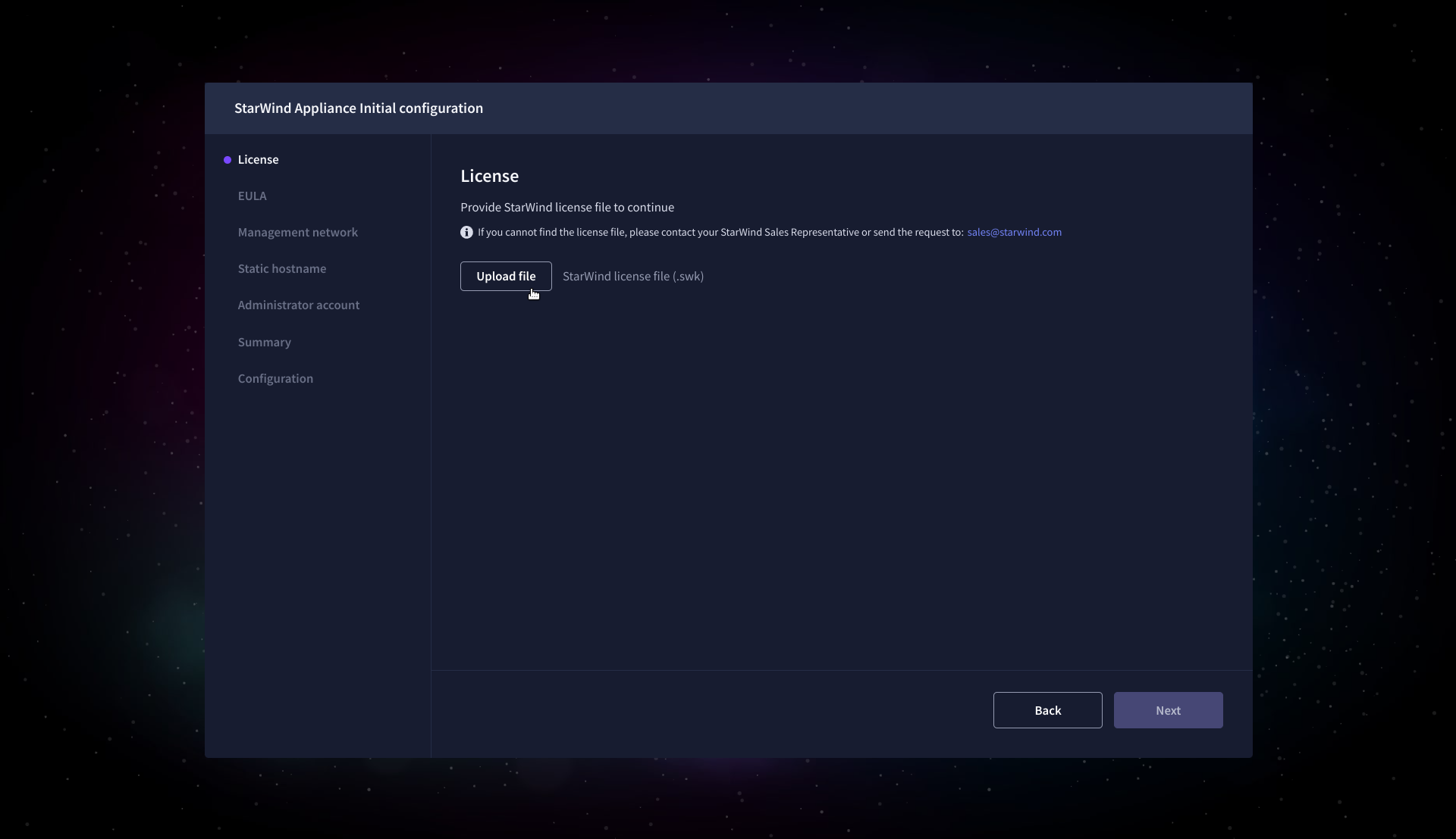
4. Read and accept the End User License Agreement to proceed.
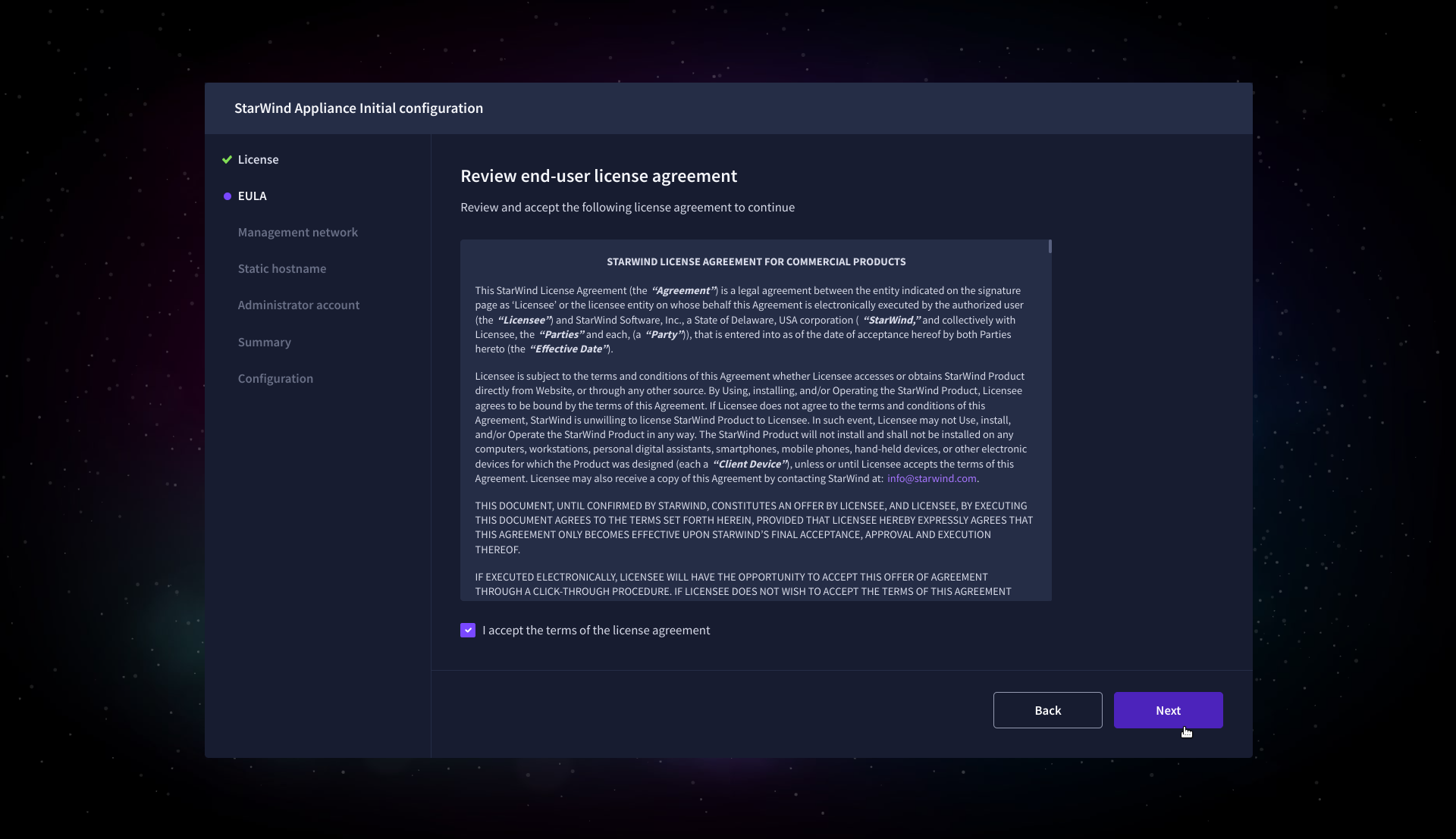
5. Review or edit the Network settings and click Next.
NOTE: Static network settings are recommended for the configuration.
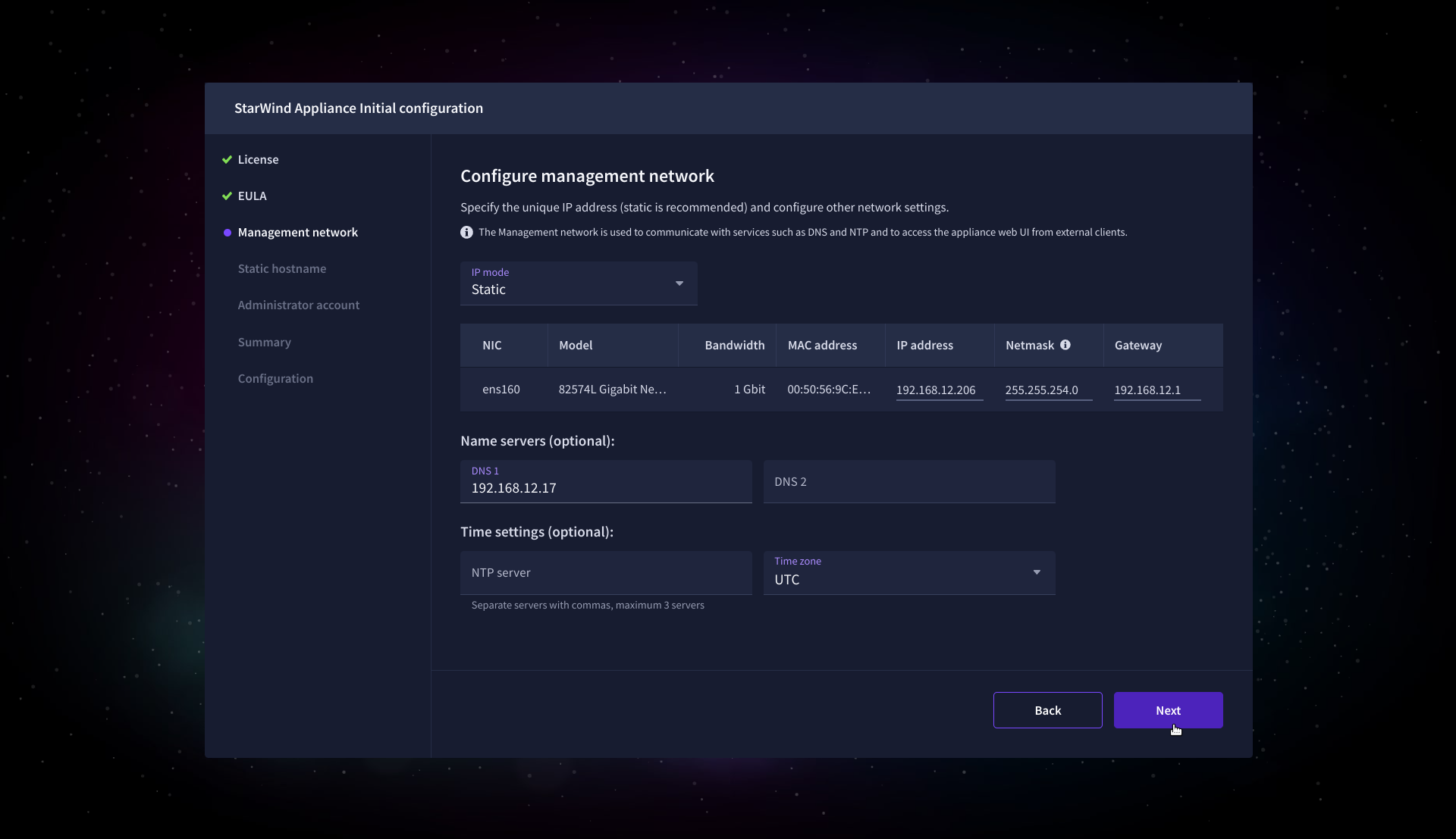
6. Specify the hostname for the VSAN appliance and click Next.
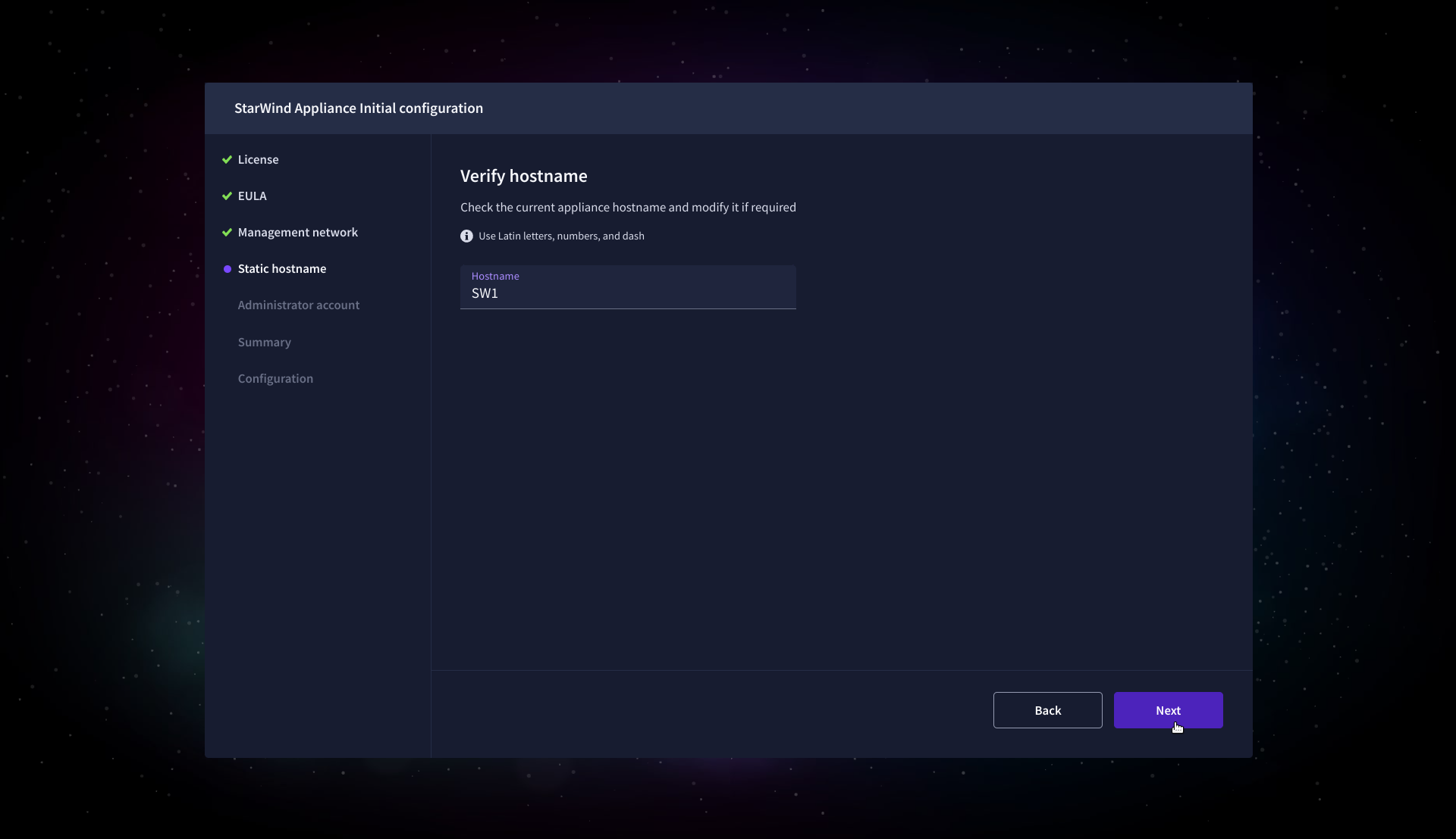
7. Create an administrator account. Click Next.
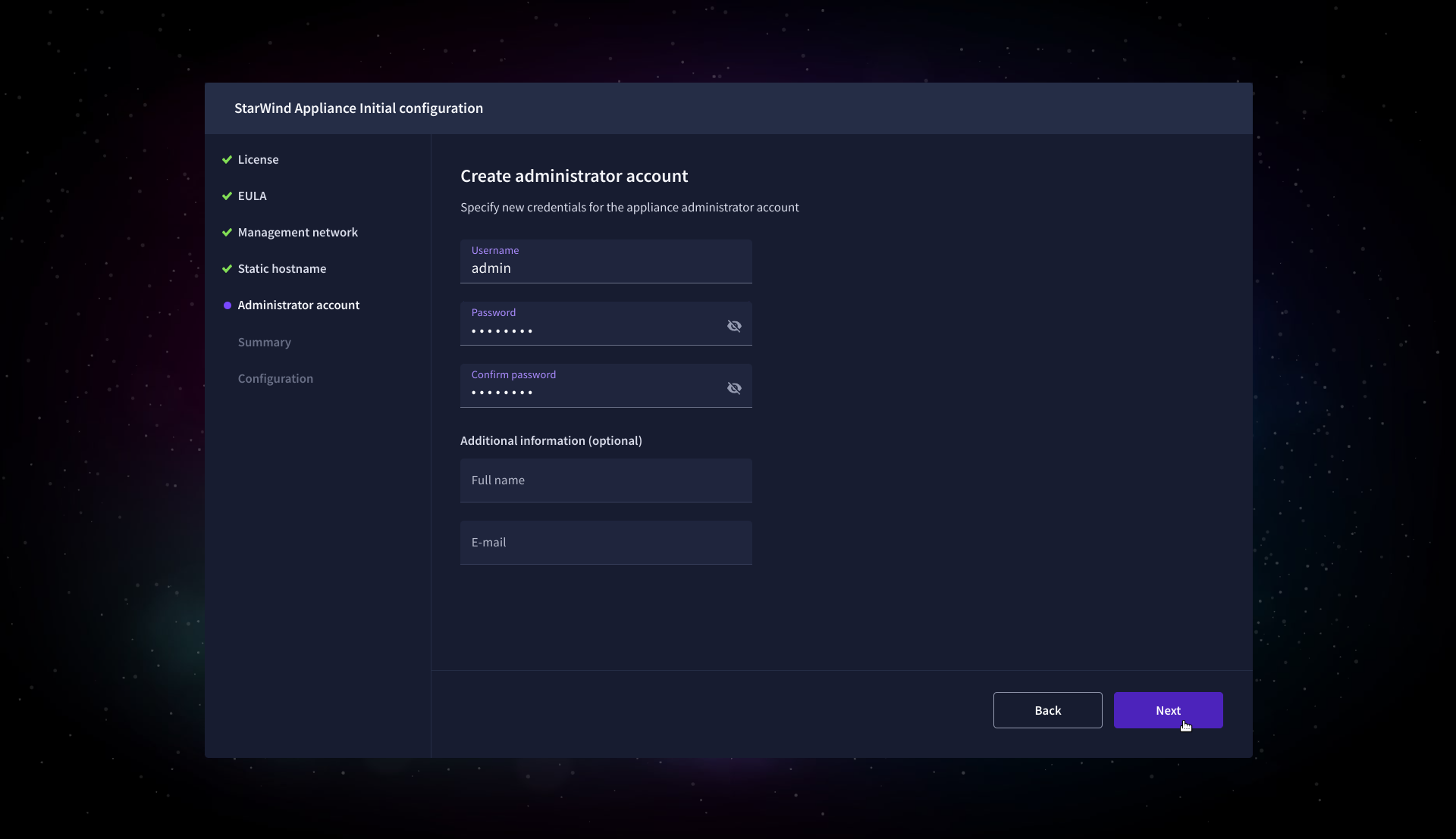
8. Review your settings selection before setting up StarWind VSAN.
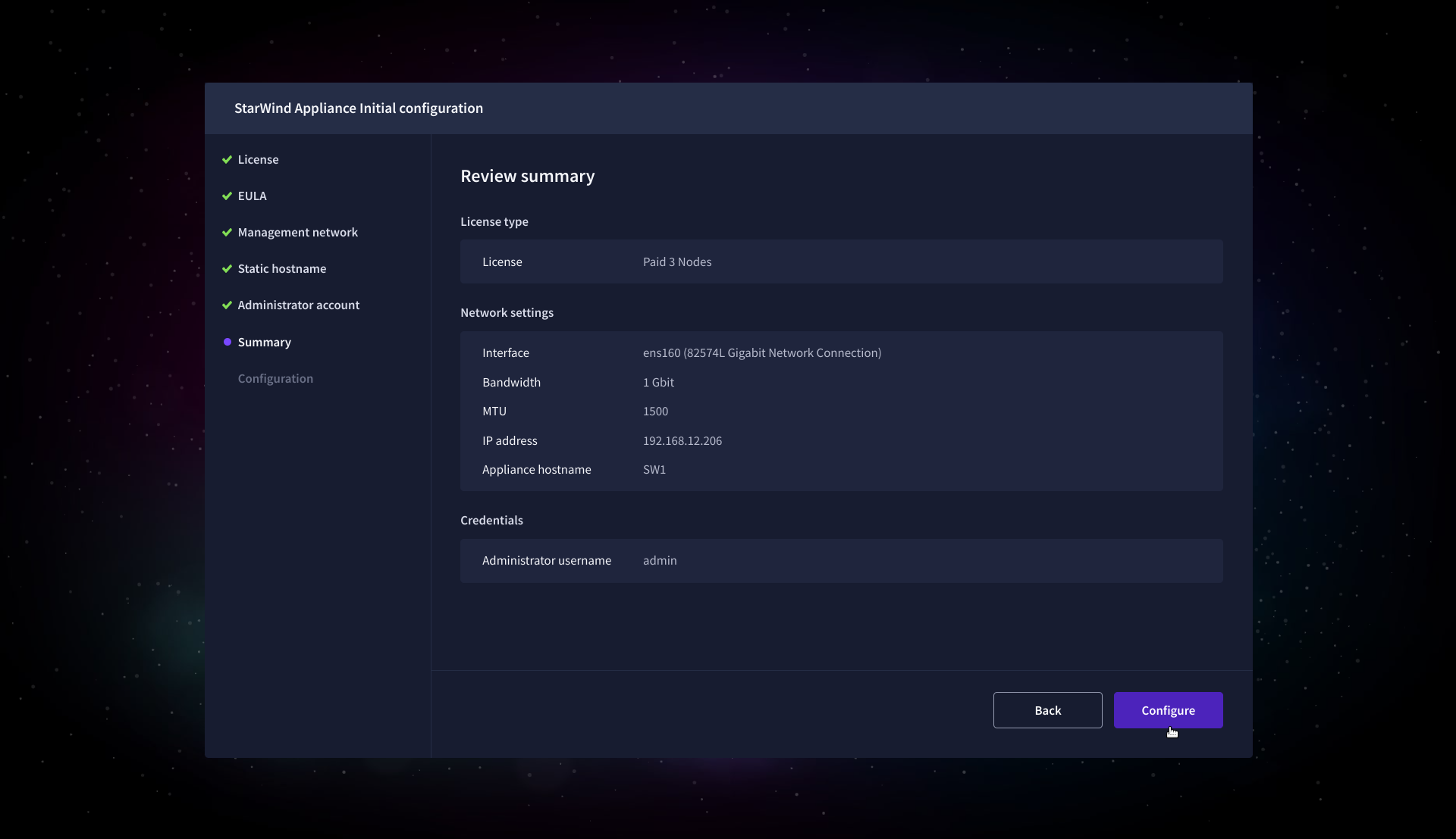
9. Please standby until the Initial Configuration Wizard configures StarWind VSAN for you.
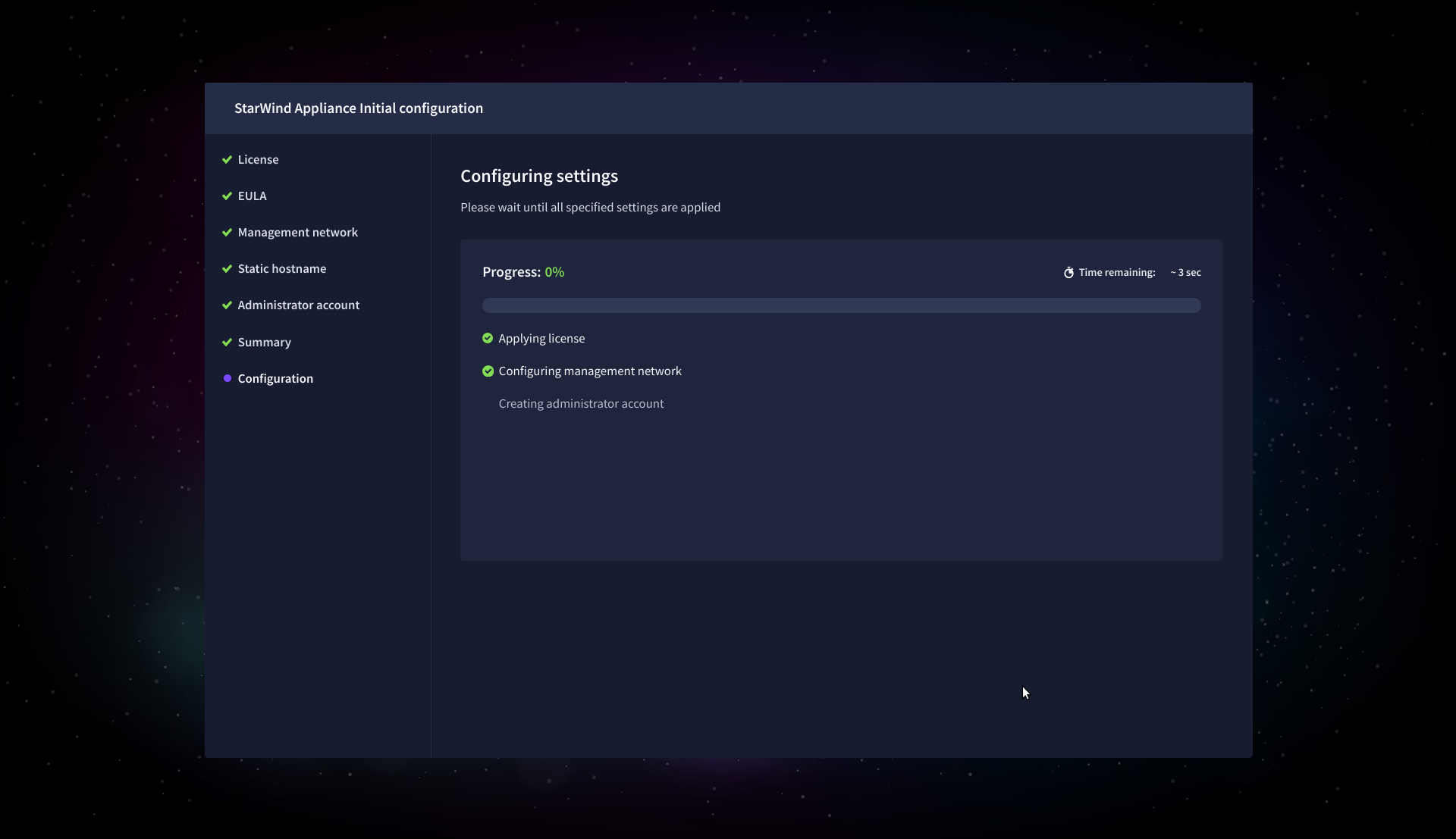
10. The appliance is set and ready. Click on the Done button to install the StarWind vCenter Plugin right now or uncheck the checkbox to skip this step and proceed to the Login page.
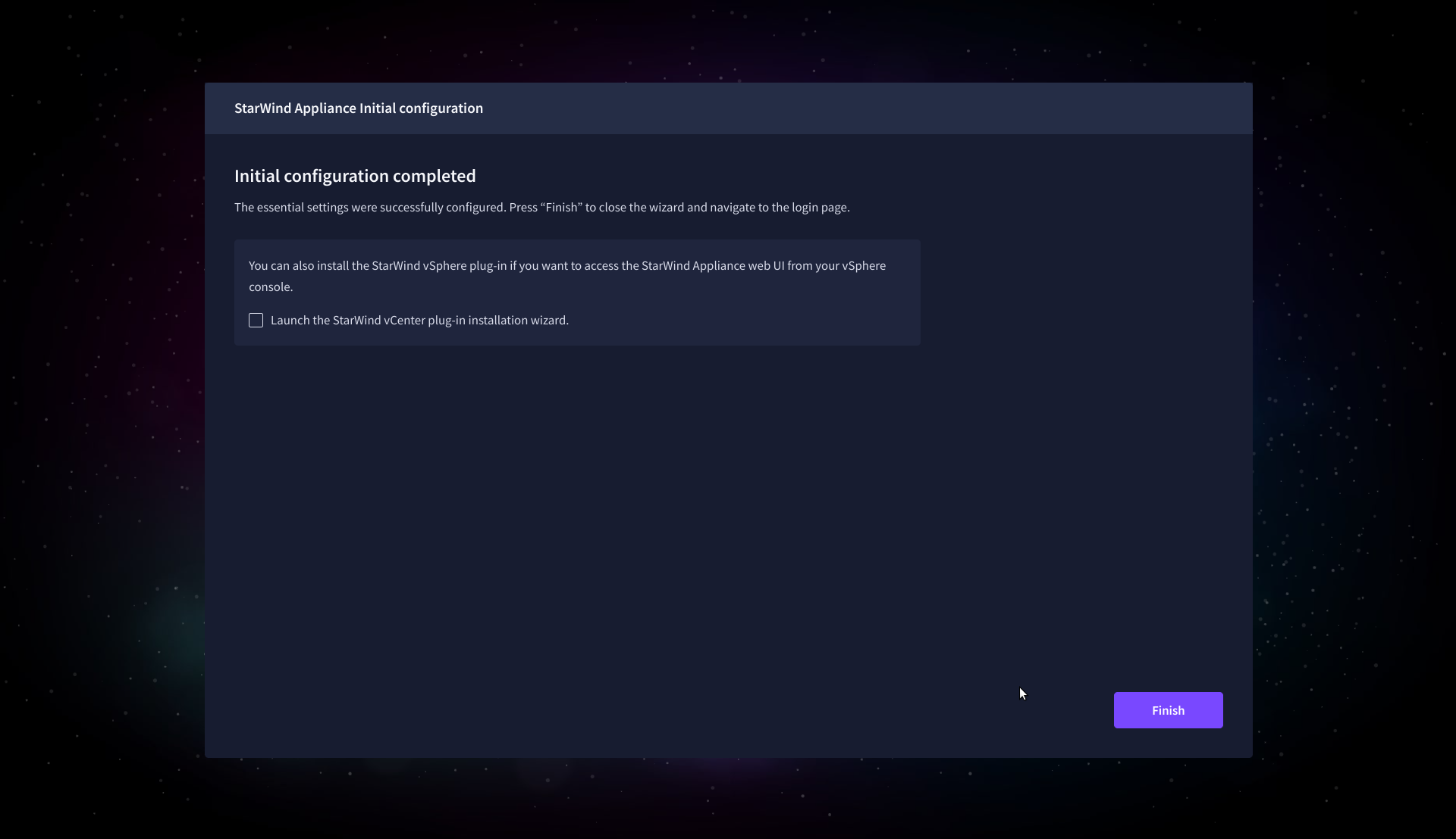
11. Repeat the initial configuration on other StarWind VSAN appliances that will be used to create 2-node or 3-node HA shared storage.
Add Appliance
To create replicated, highly available storage, add partner appliances that use the same StarWind Virtual SAN license key.
1. Navigate to the Appliances page and click Add to open the Add appliance wizard.
2. On the Credentials step, enter the IP address and credentials for the partner StarWind Virtual SAN appliance, then click Next.
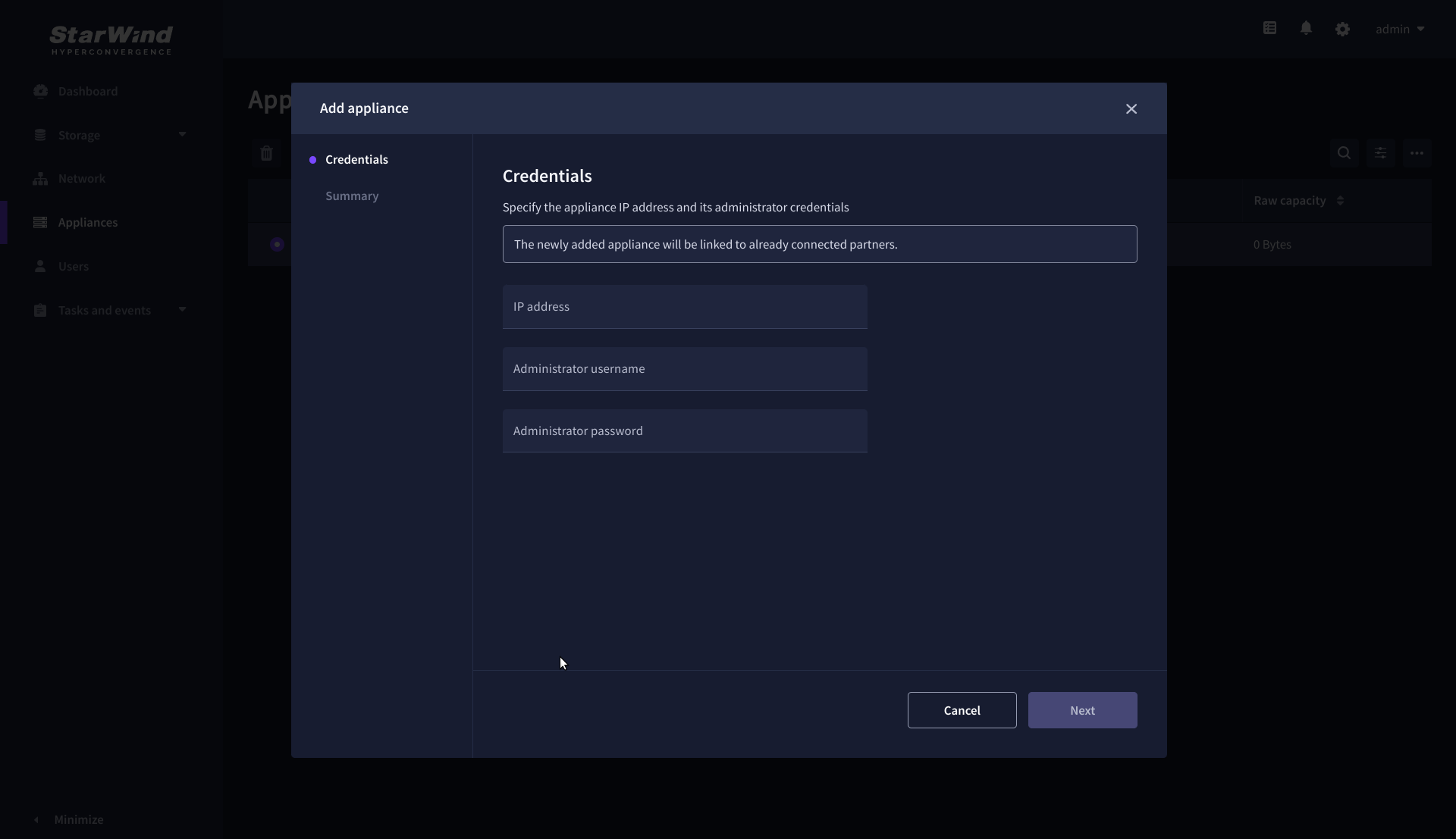
3. Provide credentials of partner appliance.
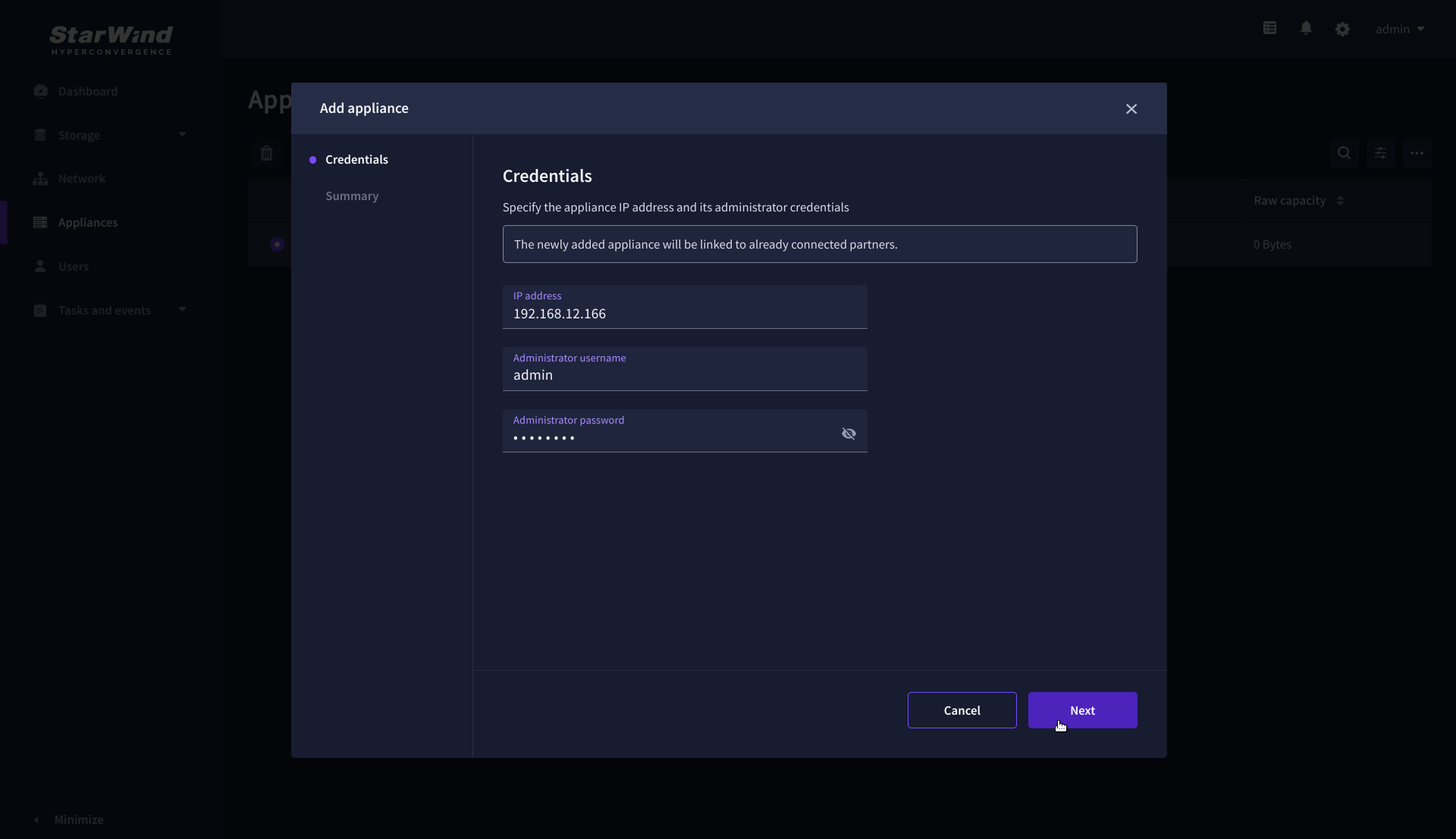
3. Wait for the connection to be established and the settings to be validated
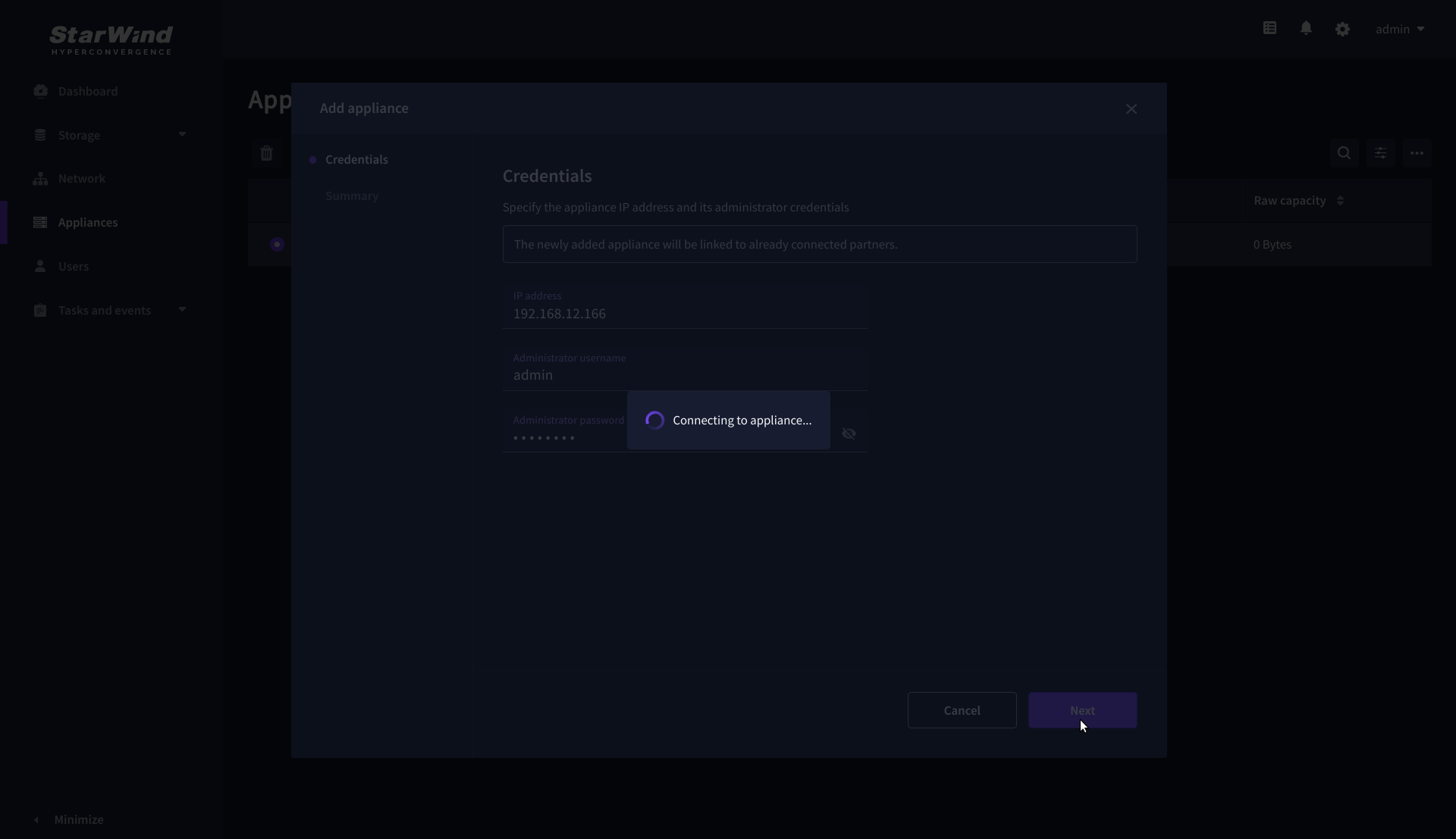
4. On the Summary step, review the properties of the partner appliance, then click Add Appliance.
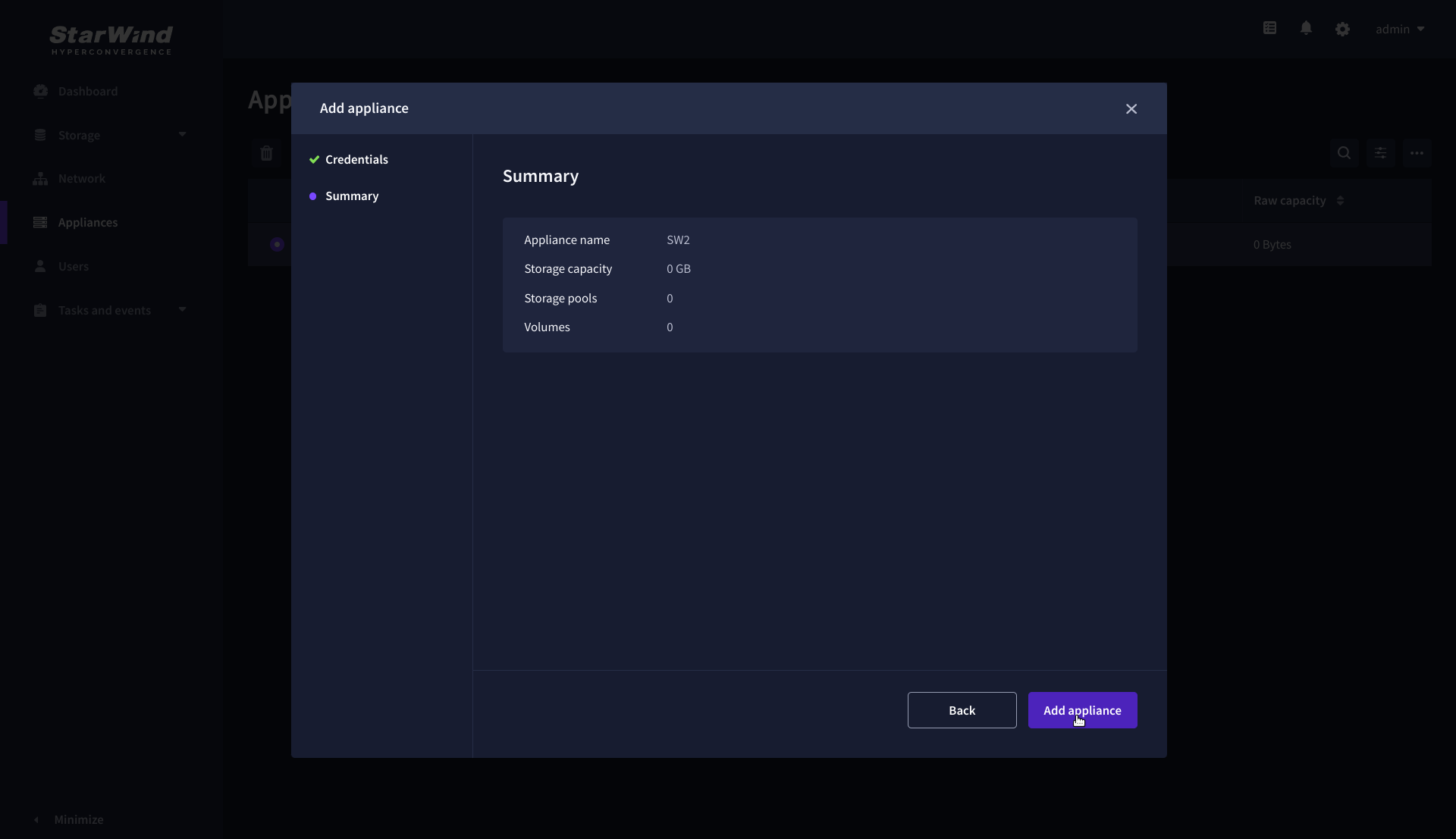
Configure HA networking
1. Navigate to the Network page and open Configure HA networking wizard.
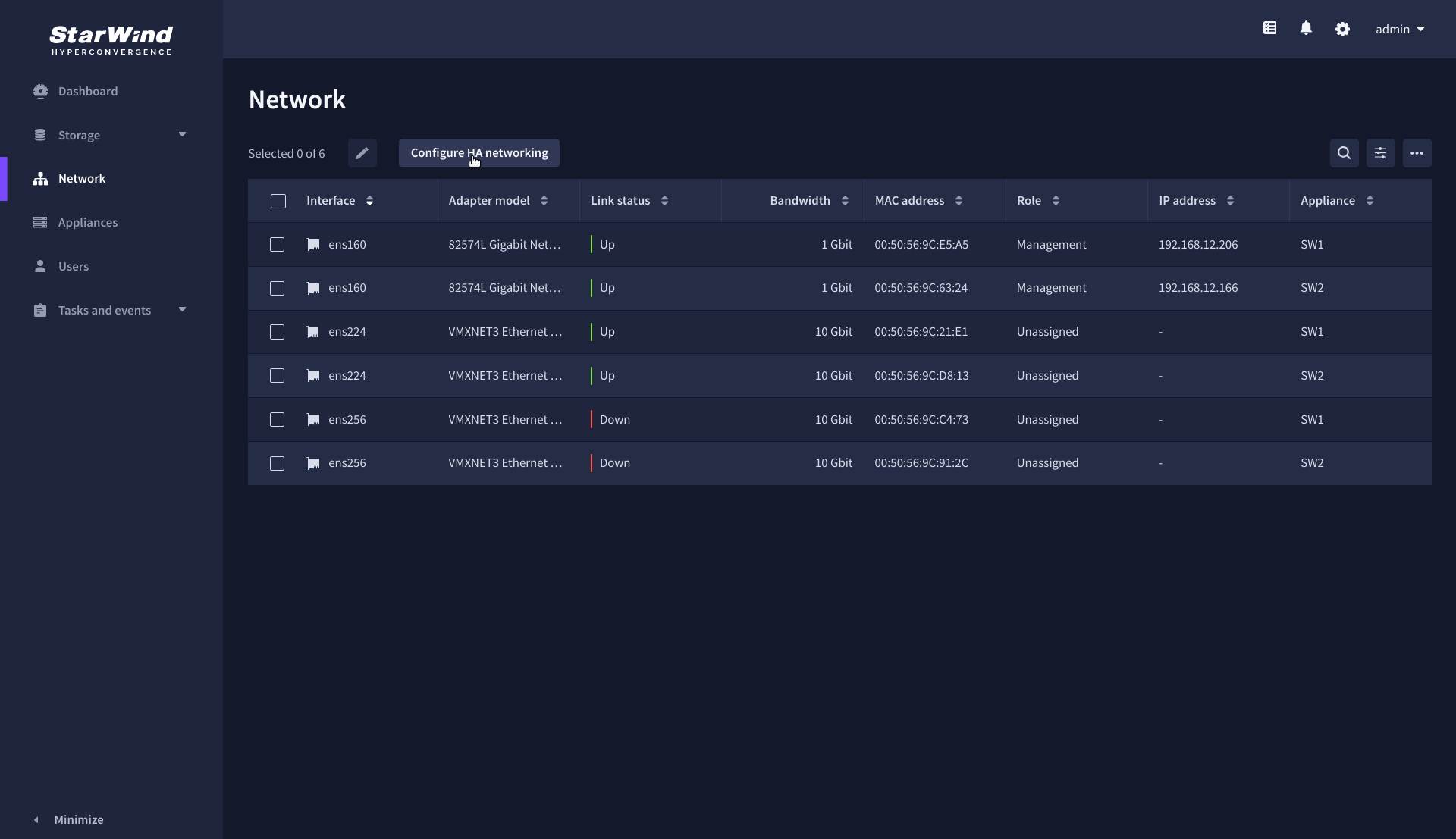
2. On the Appliances step, select either 2 partner appliances to configure two-way replication, or 3 appliances for three-way replication, then click Next.
NOTE: The number of appliances in the cluster is limited by your StarWind Virtual SAN license.
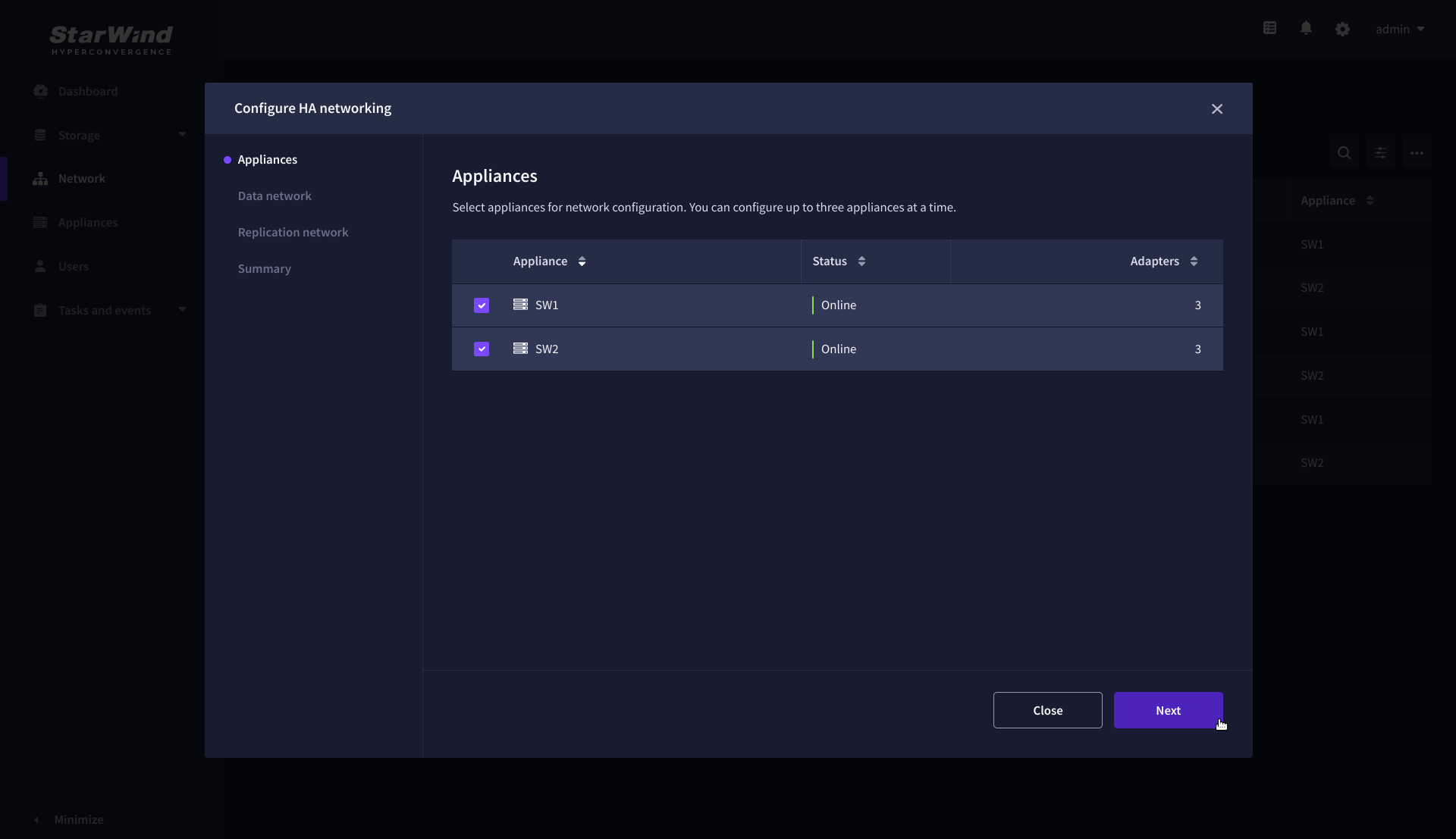
3. On the Data Network step, select the network interfaces designated to carry iSCSI or NVMe-oF storage traffic. Assign and configure at least one interface on each appliance (in our example: 172.16.10.10 and 172.16.10.20) with a static IP address in a unique network (subnet), specify the subnet mask and Cluster MTU size.
IMPORTANT: For a redundant, high-availability configuration, configure at least 2 network interfaces on each appliance. Ensure that the Data Network interfaces are interconnected between appliances through multiple direct links or via redundant switches.
4. Assign MTU value on all selected network adapters, e.g. 1500 or 9000 bytes. If you are using network switches with the selected Data Network adapters, ensure that they are configured with the same MTU size value. In case of MTU settings mismatch, stability and performance issues might occur on the whole setup.
NOTE: Setting MTU to 9000 bytes on some physical adapters (like Intel Ethernet Network Adapter X710, Broadcom network adapters, etc.) might cause stability and performance issues depending on the installed network driver. To avoid them, use 1500 bytes MTU size or install the stable version of the driver.
5. Once configured, click Next to validate network settings.

6. The warning might appear if a single data interface is configured. Click Yes, continue to proceed with the configuration.
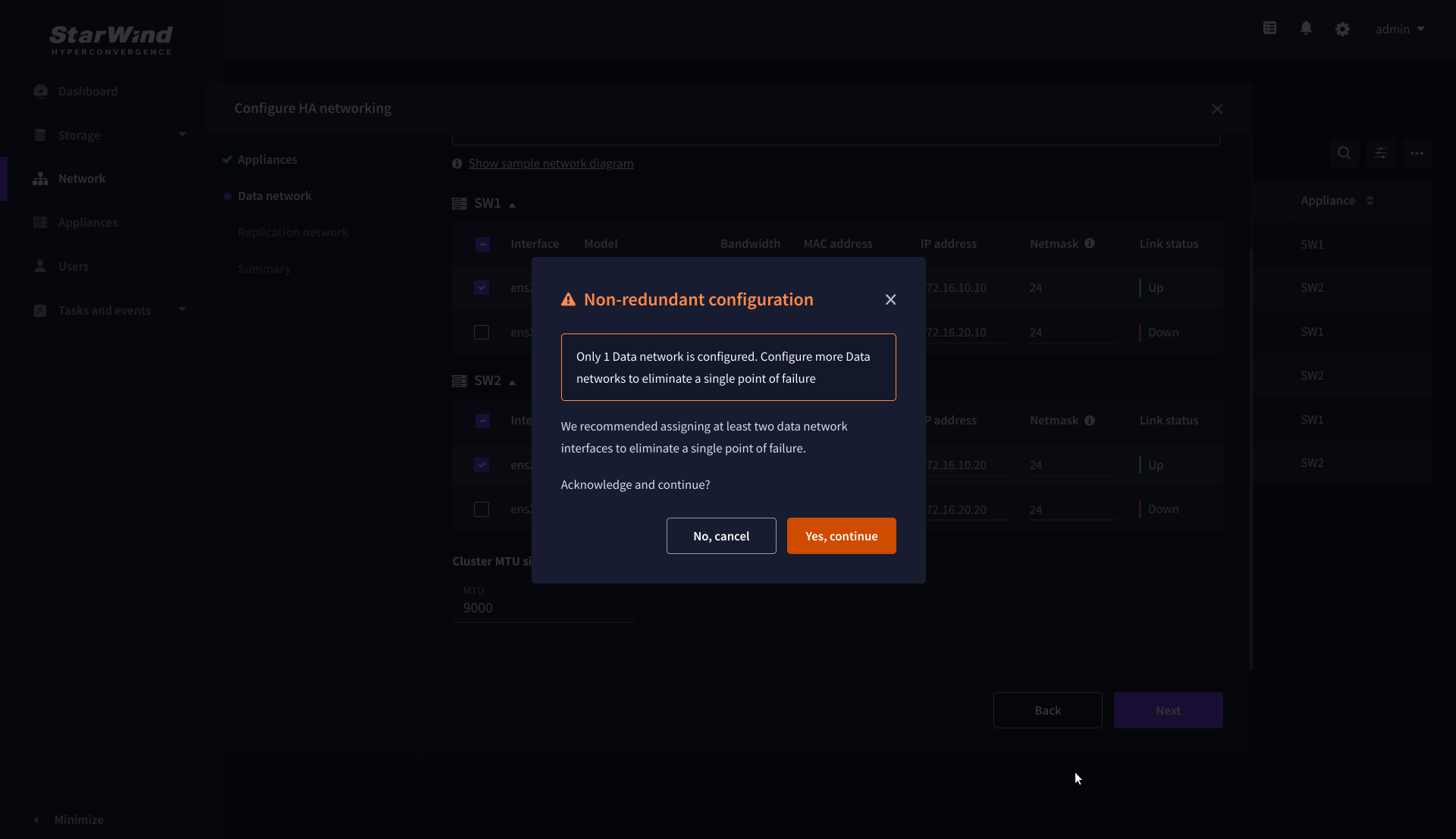
7. On the Replication Network step, select the network interfaces designated to carry the traffic for synchronous replication. Assign and configure at least one interface on each appliance with a static IP address in a unique network (subnet), specify the subnet mask and Cluster MTU size.
IMPORTANT: For a redundant, high-availability configuration, configure at least 2 network interfaces on each appliance. Ensure that the Replication Network interfaces are interconnected between appliances through multiple direct links or via redundant switches.
8. Assign MTU value on all selected network adapters, e.g. 1500 or 9000 bytes. If you are using network switches with the selected Replication Network adapters, ensure that they are configured with the same MTU size value. In case of MTU settings mismatch, stability and performance issues might occur on the whole setup.
NOTE: Setting MTU to 9000 bytes on some physical adapters (like Intel Ethernet Network Adapter X710, Broadcom network adapters, etc.) might cause stability and performance issues depending on the installed network driver. To avoid them, use 1500 bytes MTU size or install the stable version of the driver.
9. Once configured, click Next to validate network settings.
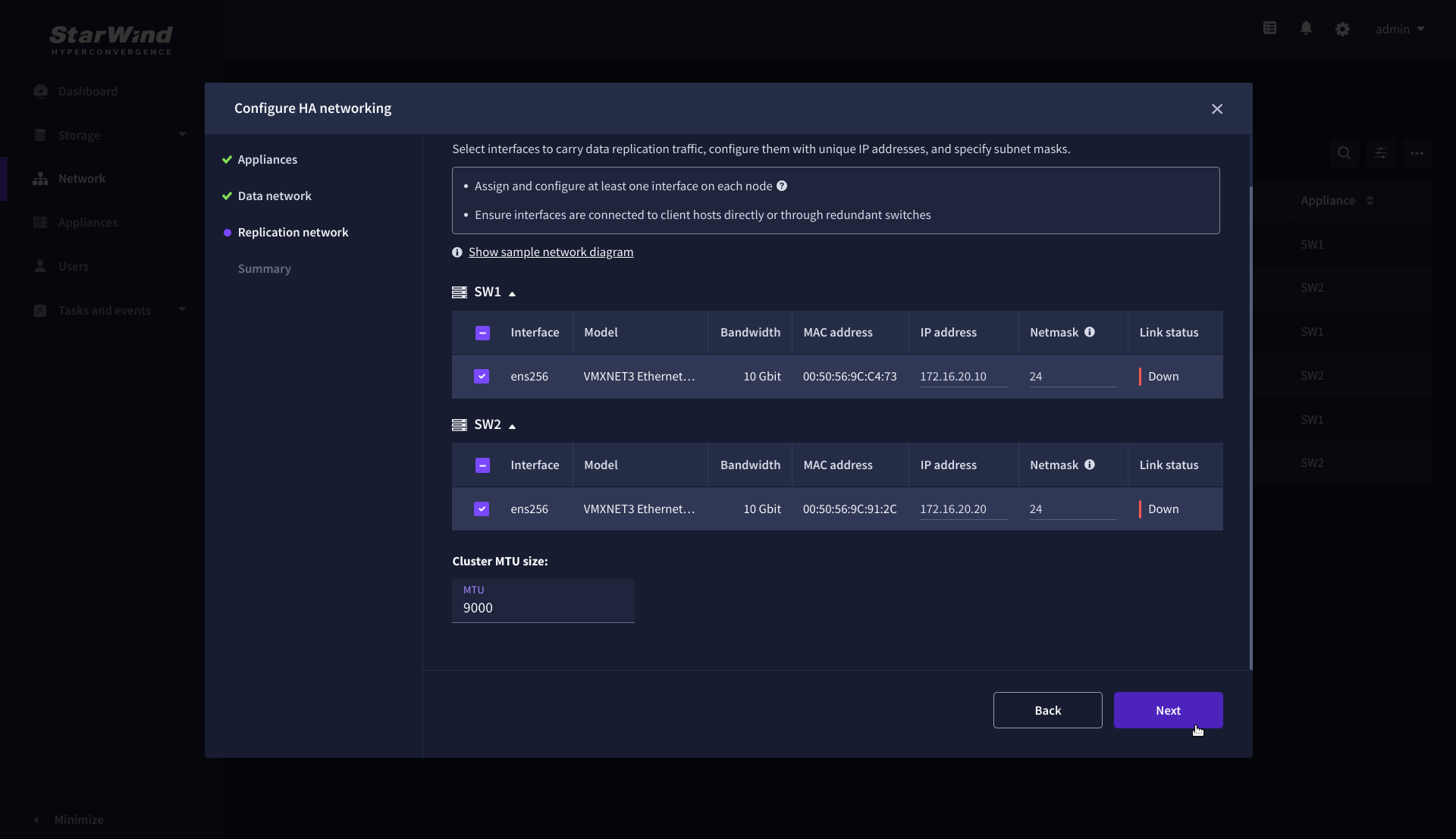
10. If only one Replication Network interface is configured on each partner appliance, a warning message will pop up. Click Yes, continue to acknowledge the warning and proceed.
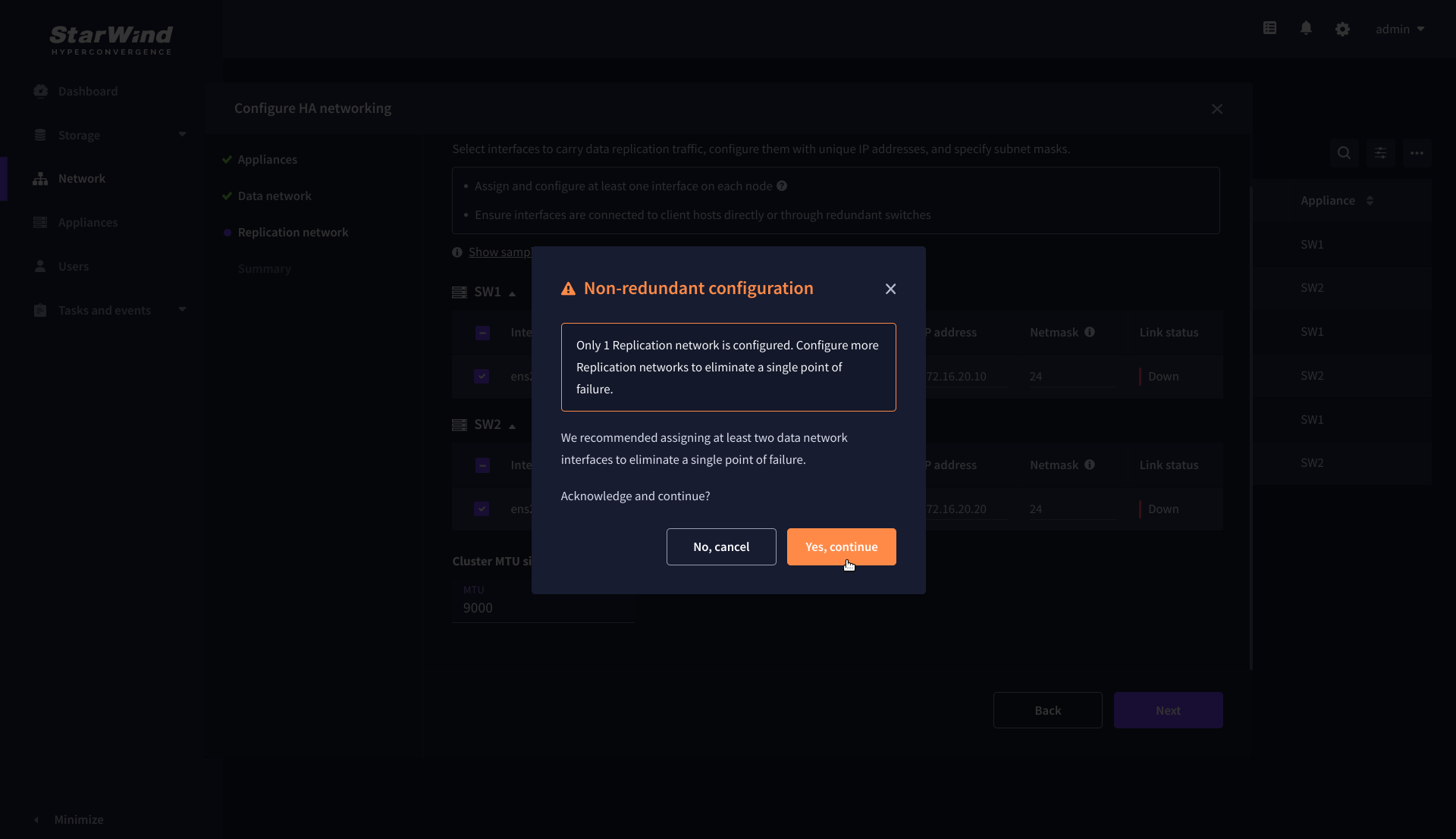
11. Wait for the configuration completion.
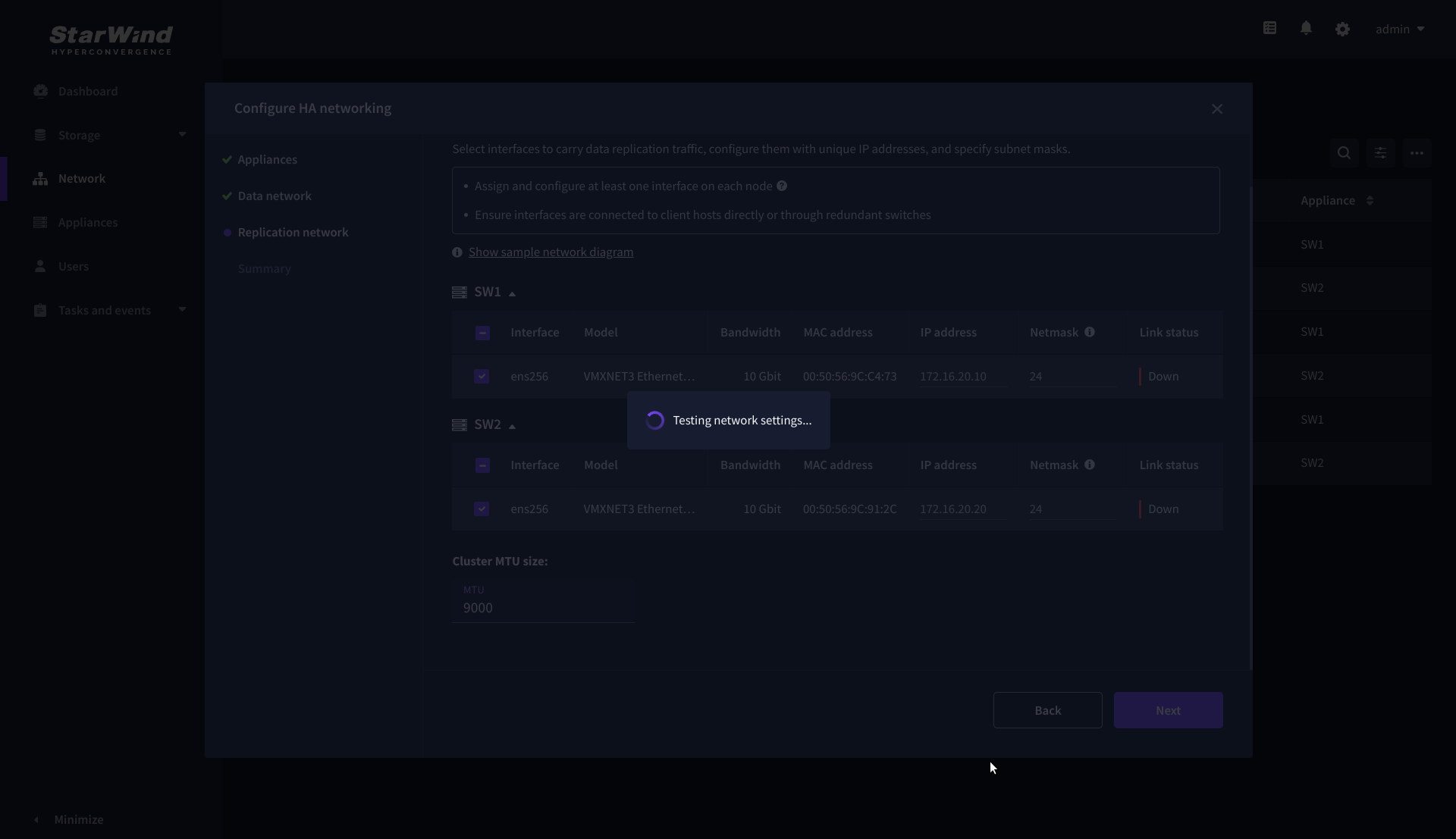
12. On the Summary step, review the specified network settings and click Configure to apply the changes.
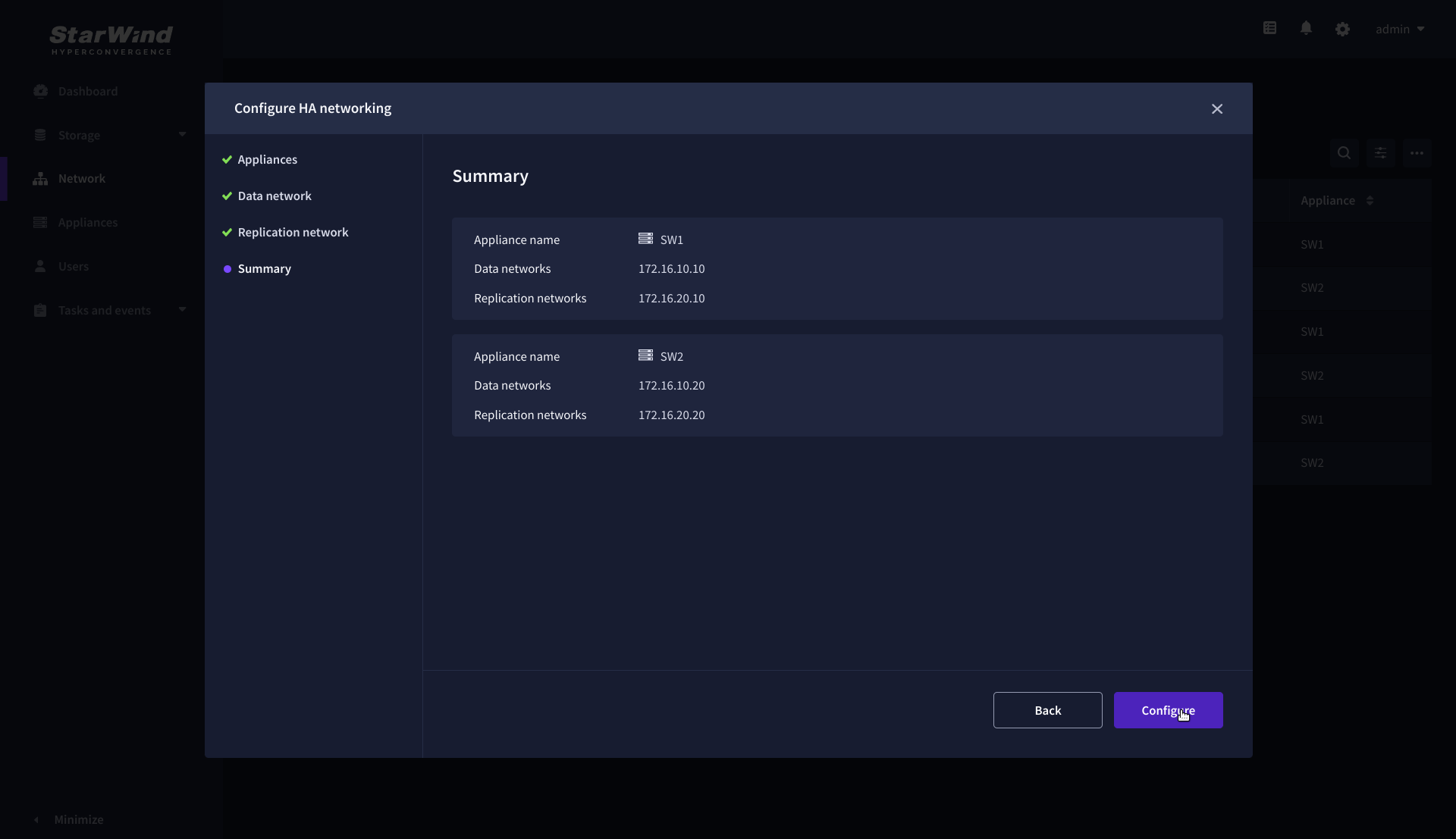
Add physical disks
Attach physical storage to StarWind Virtual SAN Controller VM:
- Ensure that all physical drives are connected through an HBA or RAID controller.
- To get the optimal storage performance, add HBA, RAID controllers, or NVMe SSD drives to StarWind CVM via a passthrough device.
For detailed instructions, refer to Microsoft’s documentation on DDA. Also, find the storage provisioning guidelines in the KB article.
Create Storage Pool
1. Navigate to the Storage pools page and click the + button to open the Create storage pool wizard .
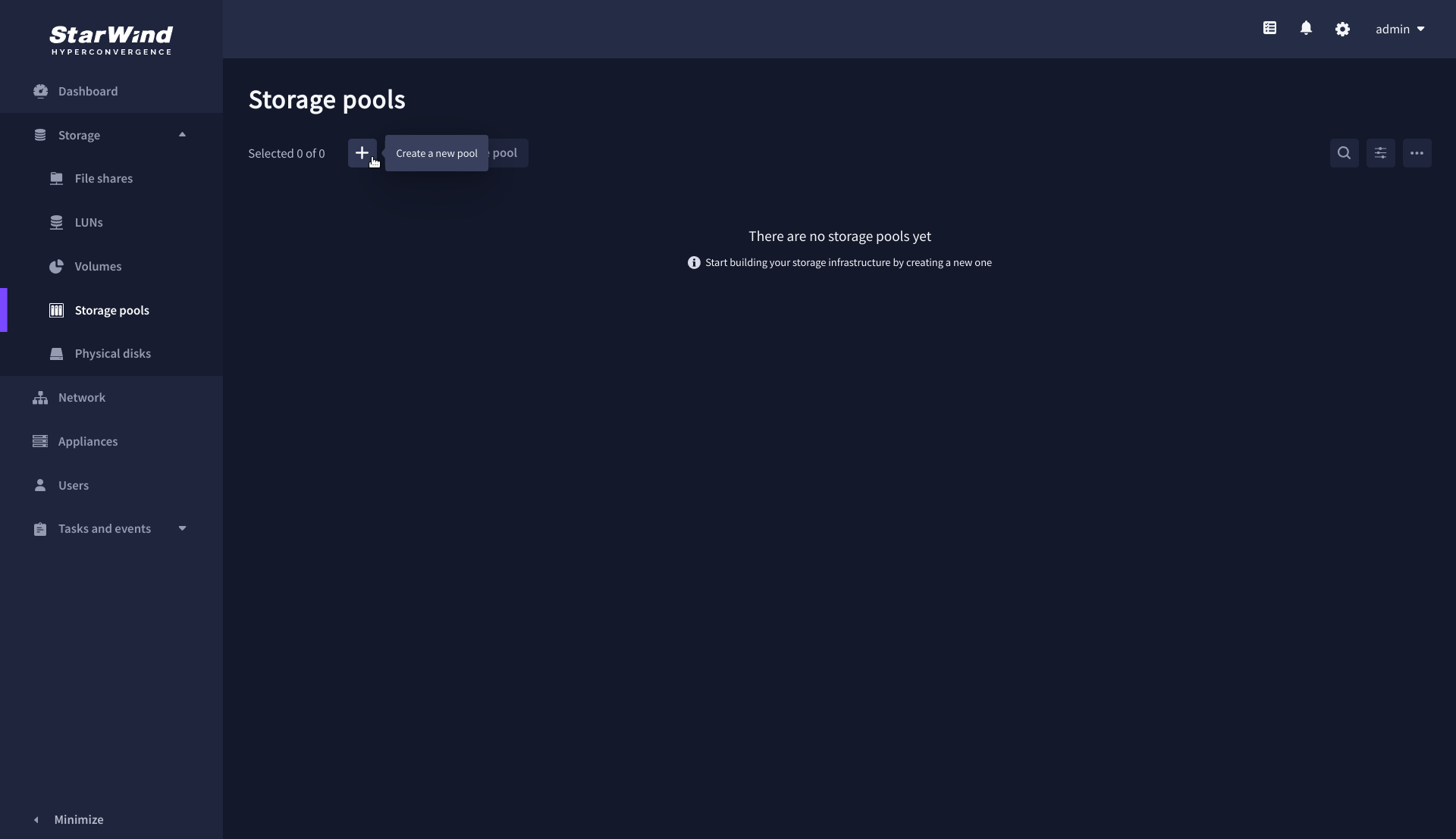
2. On the Appliance step, select partner appliances on which to create new storage pools, then click Next.
NOTE: Select 2 appliances for configuring storage pools if you are deploying a two-node cluster with two-way replication, or select 3 appliances for configuring a three-node cluster with a three-way mirror.
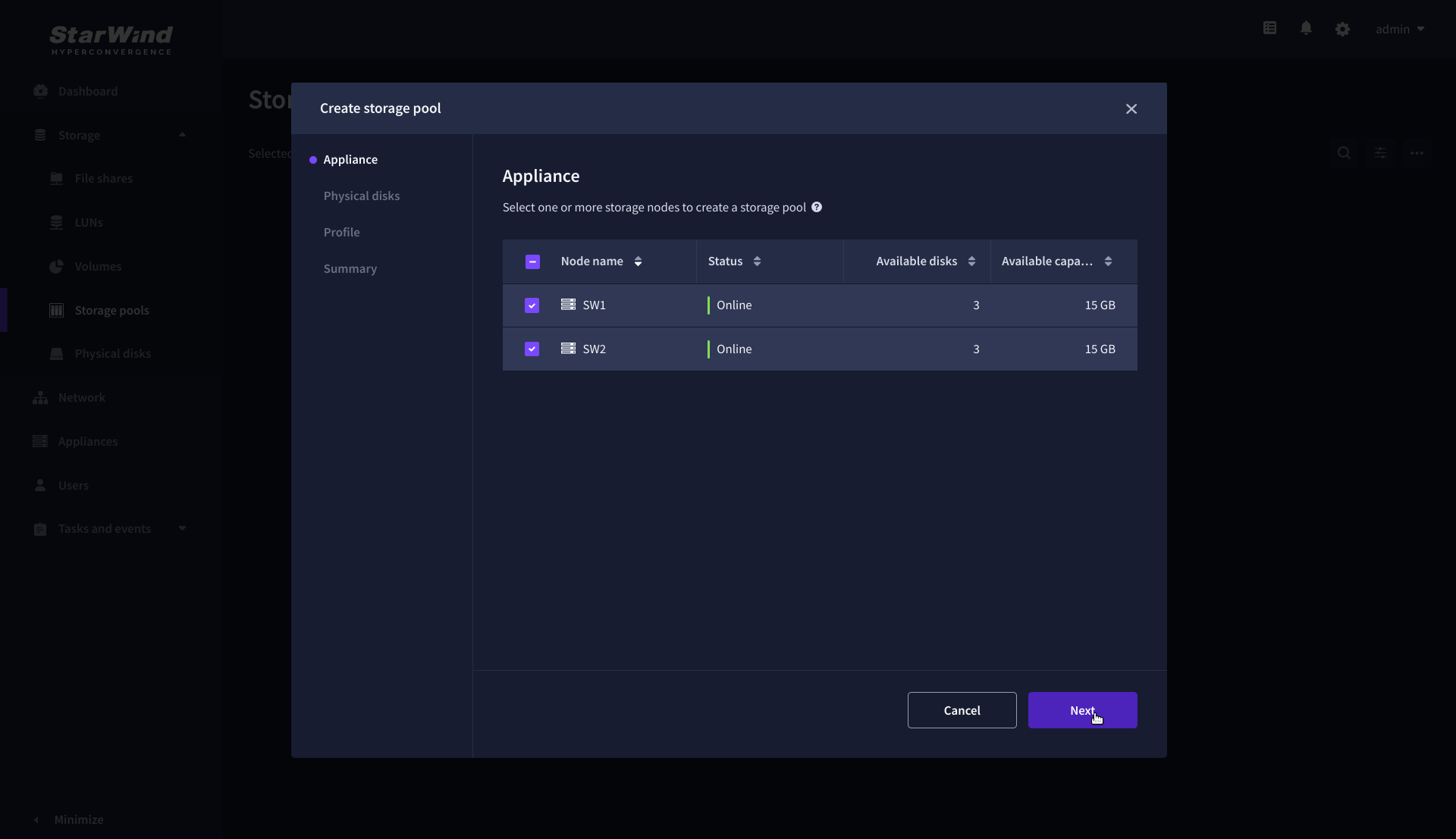
3. On the Physical disks step, select physical disks to be pooled on each node, then click Next.
IMPORTANT: Select an identical type and number of disks on each appliance to create storage pools with a uniform configuration.
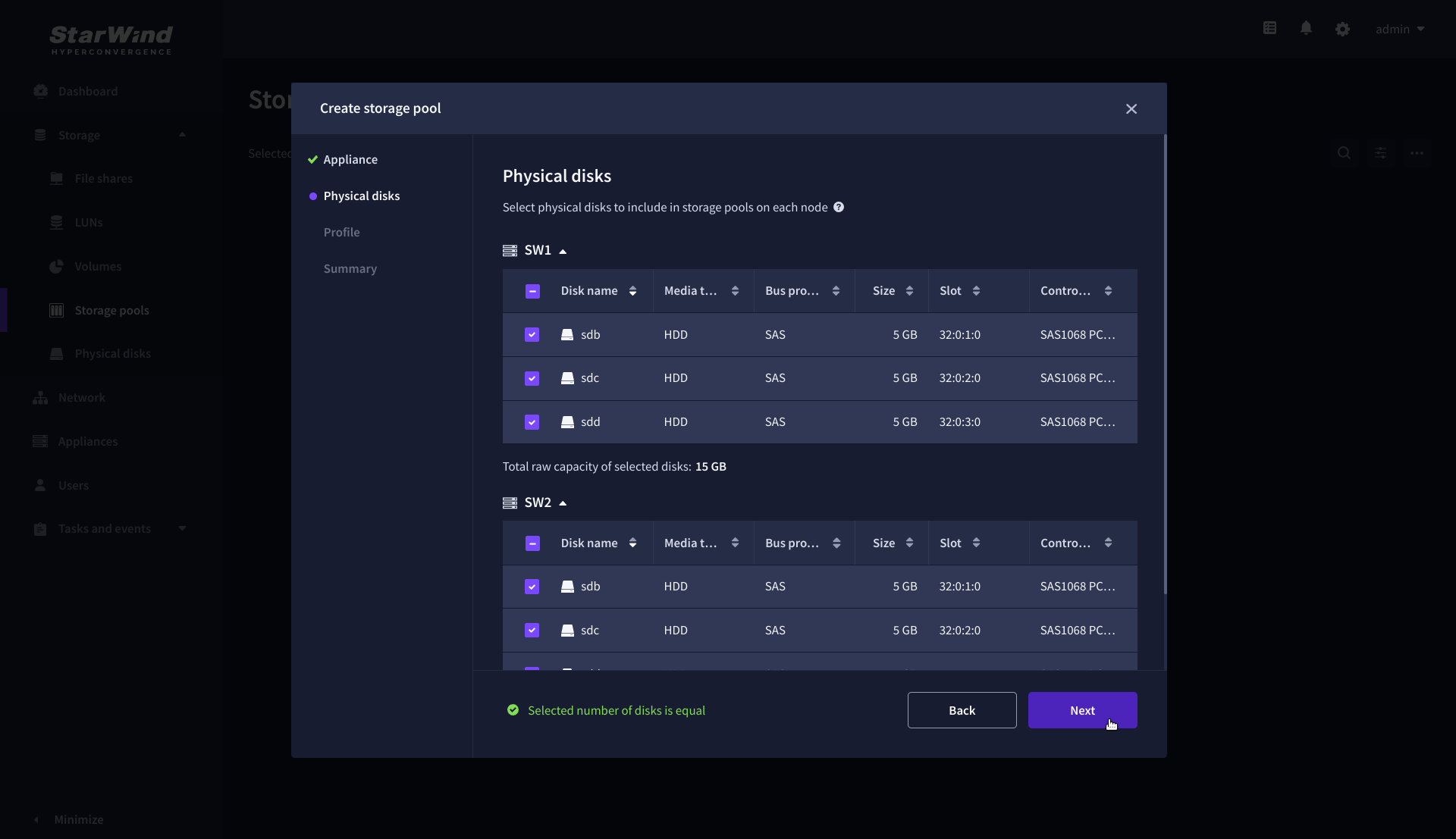
4. On the Profile step, select one of the preconfigured storage profiles, or choose Manual to configure the storage pool manually based on your redundancy, capacity, and performance requirements, then click Next.
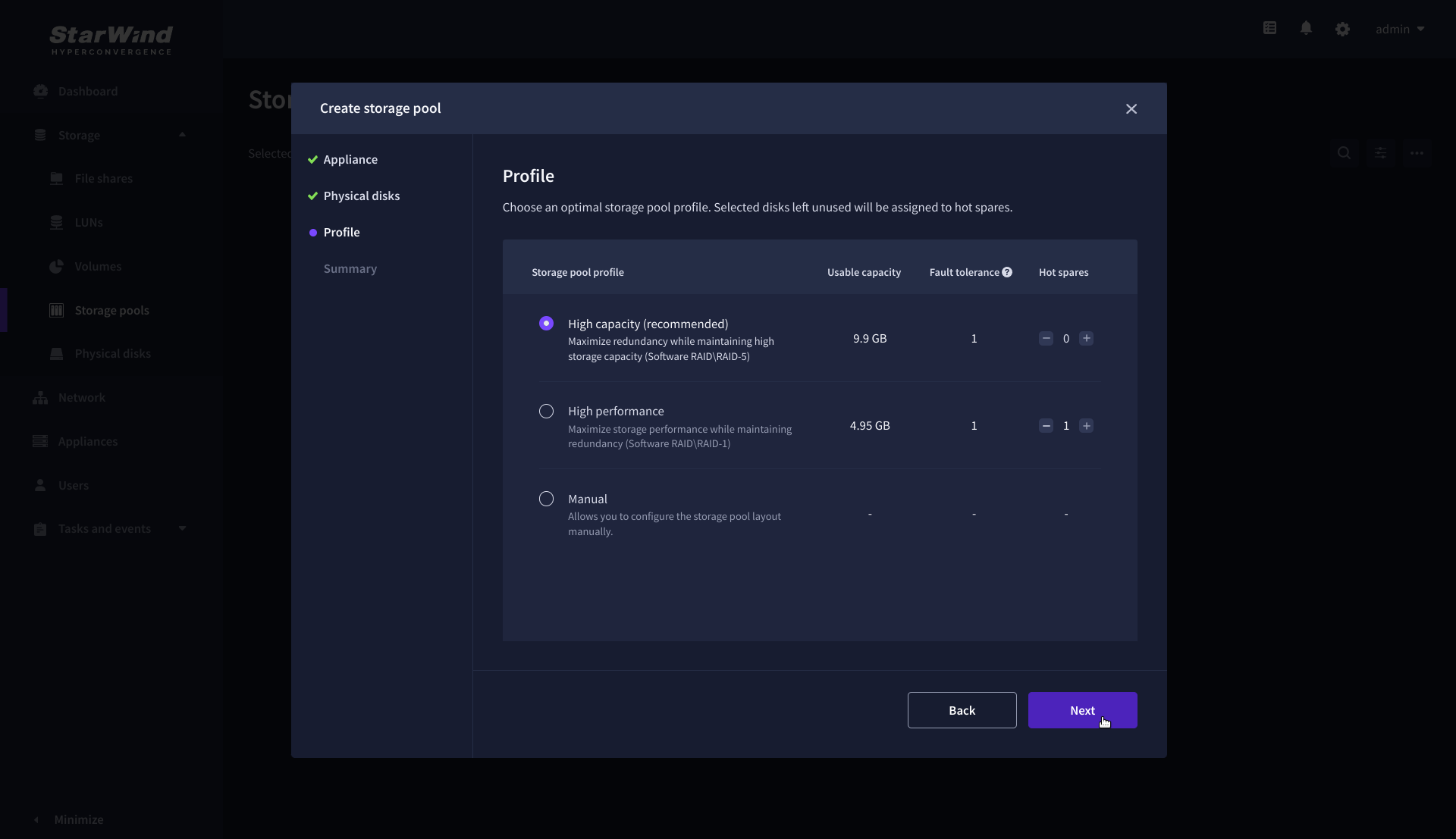
NOTE: Hardware RAID, Linux Software RAID, and ZFS storage pools are supported. To simplify the configuration of storage pools, preconfigured storage profiles are provided. These profiles recommend a pool type and layout based on the attached storage:
- High capacity – creates Linux Software RAID-5 to maximize storage capacity while maintaining redundancy.
- High performance – creates Linux Software RAID-10 to maximize storage performance while maintaining redundancy.
- Hardware RAID – configures a hardware RAID virtual disk as a storage pool. This option is available only if a hardware RAID controller is passed through to the StarWind Virtual SAN.
- Better redundancy – creates ZFS Striped RAID-Z2 (RAID 60) to maximize redundancy while maintaining high storage capacity.
- Manual – allows users to configure any storage pool type and layout with the attached storage.
5. On the Summary step, review the storage pool settings and click Create to configure new storage pools on the selected appliances.
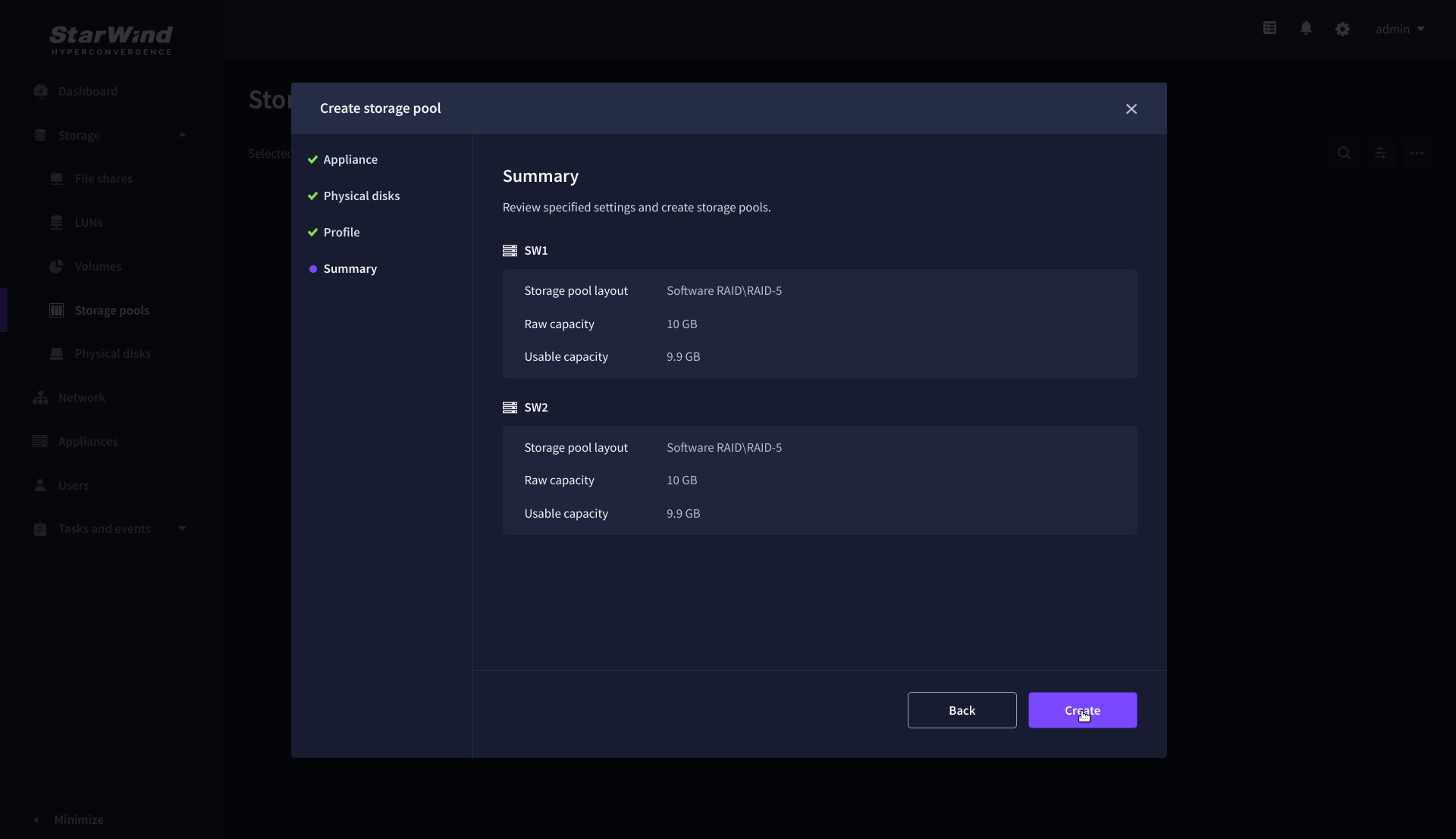
NOTE: The storage pool configuration may take some time, depending on the type of pooled storage and the total storage capacity. Once the pools are created, a notification will appear in the upper right corner of the Web UI.
IMPORTANT: In some cases, additional tweaks are required to optimize the storage performance of the disks added to the Controller Virtual Machine. Please follow the steps in this KB to change the scheduler type depending on the disks type: https://knowledgebase.starwindsoftware.com/guidance/starwind-vsan-for-vsphere-changing-linux-i-o-scheduler-to-optimize-storage-performance/
Create Volume
1. Navigate to the Volumes page and click the + button to open the Create volume wizard.
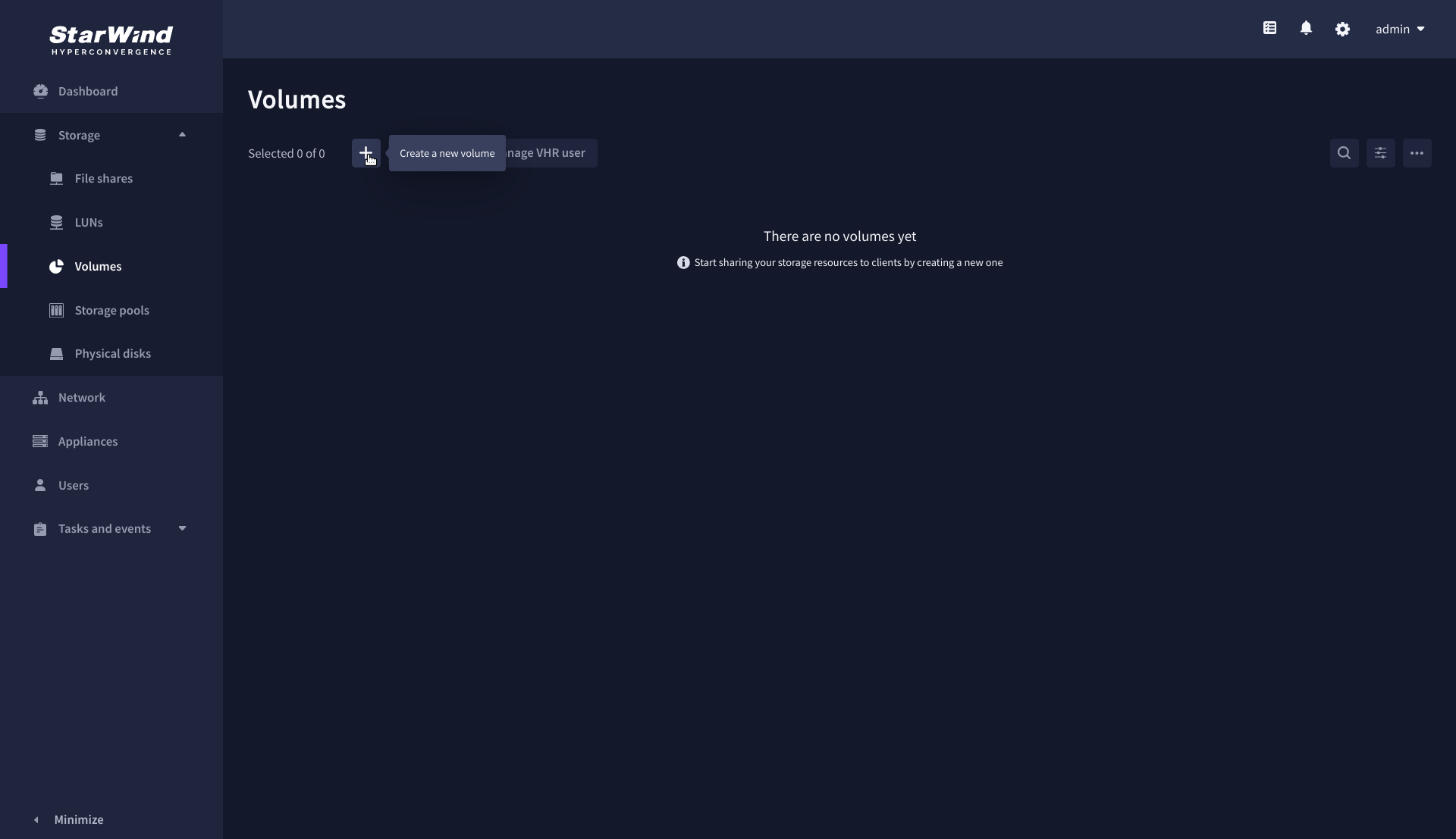
2. On the Storage pool step, select partner appliances on which to create new volumes, then click Next.
NOTE: Select 2 appliances for configuring volumes if you are deploying a two-node cluster with two-way replication, or select 3 appliances for configuring a three-node cluster with a three-way mirror.
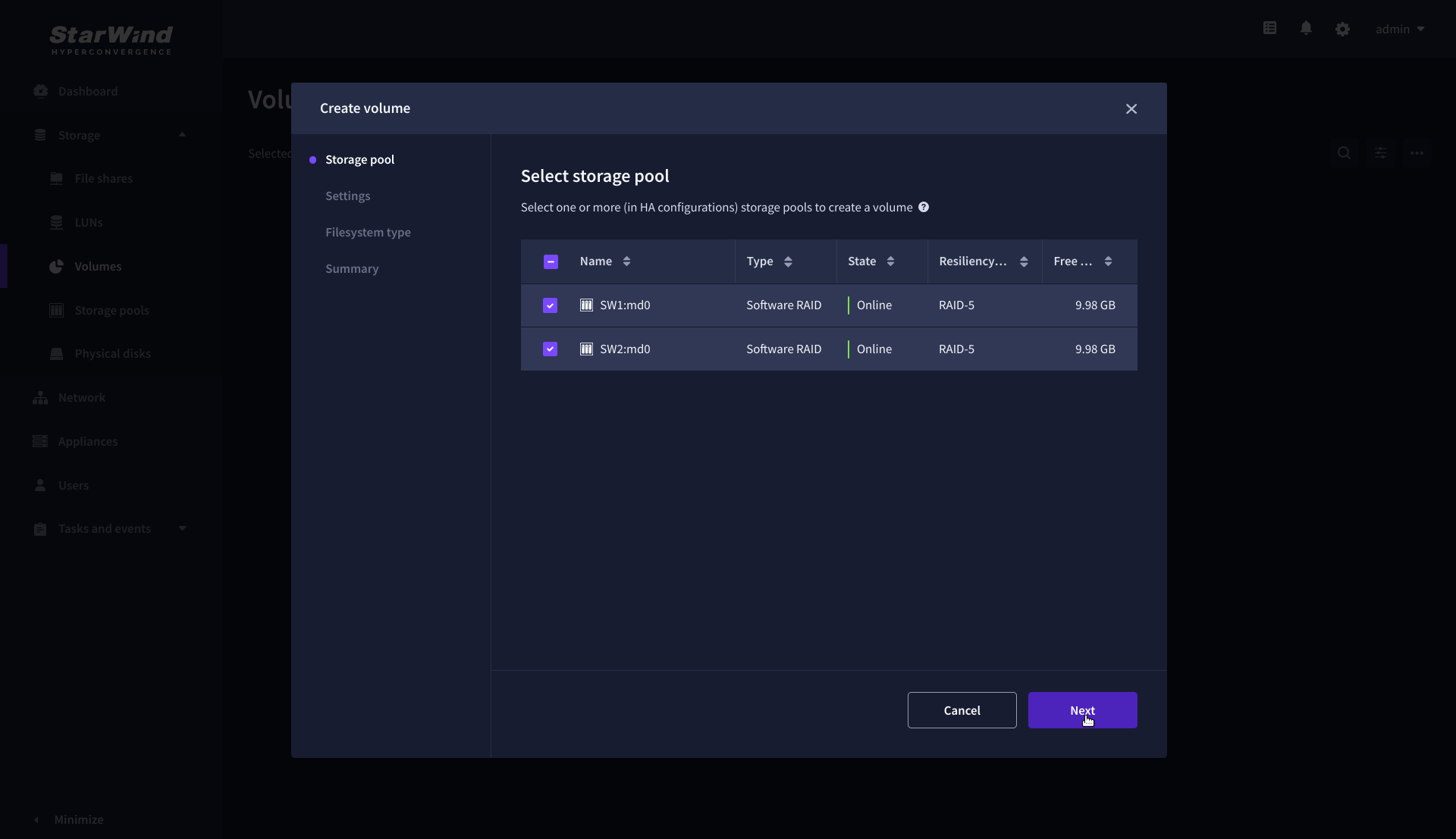
3. On the Settings step, specify the volume name and size, then click Next.

4. On the Filesystem type step, select Standard, then click Next.
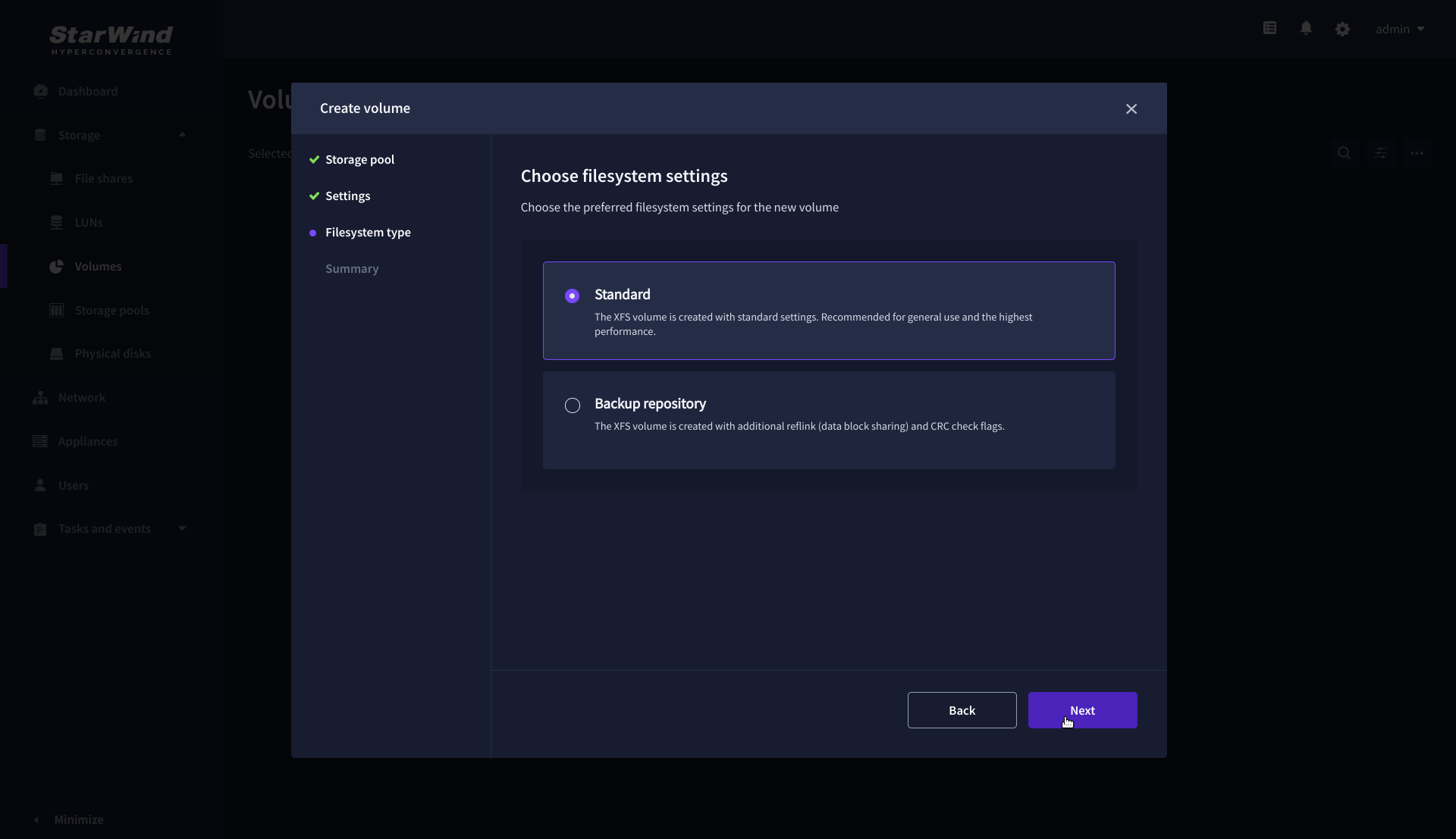
5. Review Summary and click the Create button to create the pool.
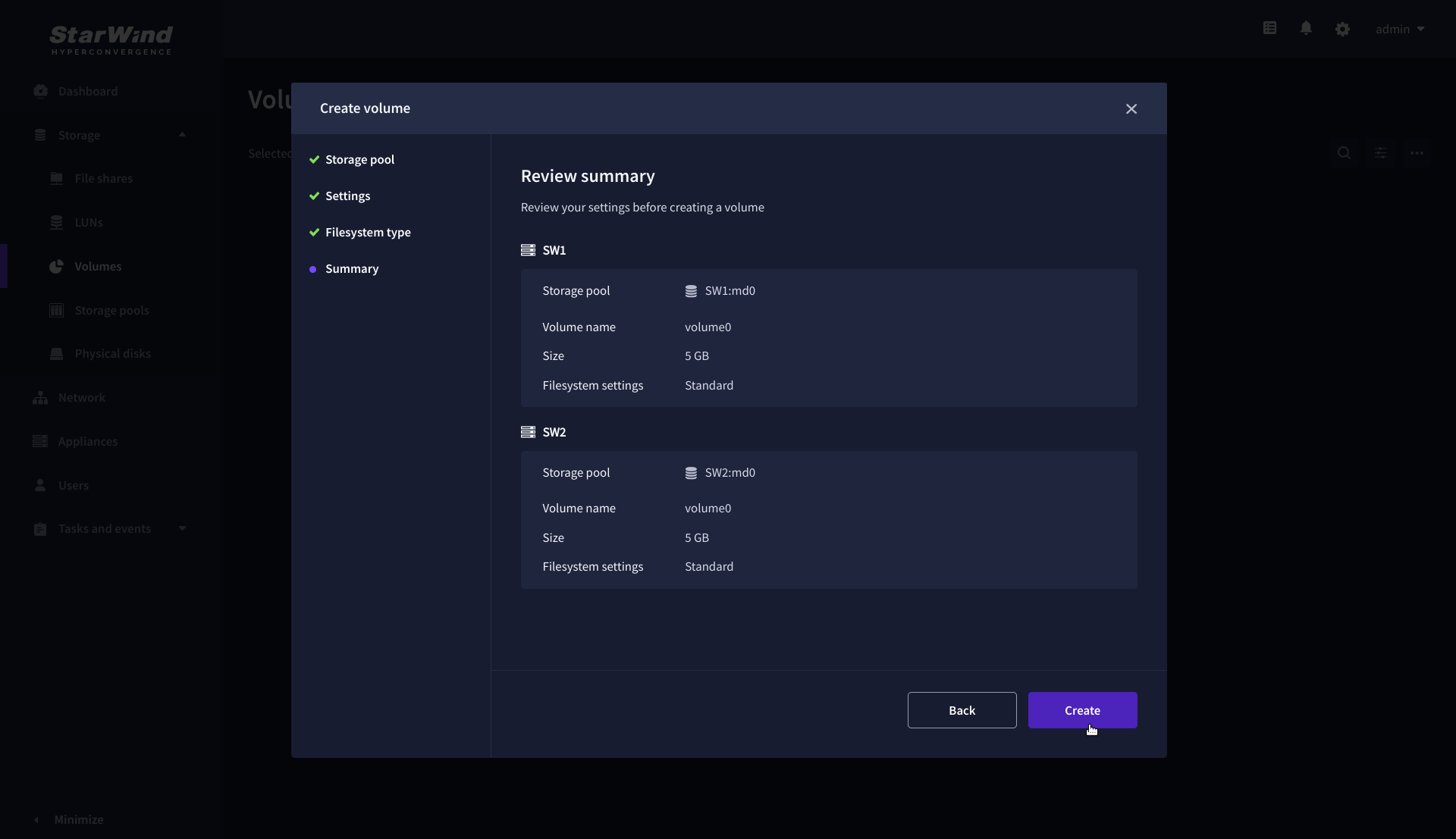
Create HA LUN using WebUI
This section describes how to create LUN in Web UI. This option is available for the setups with Commercial, Trial, and NFR licenses applied.
For setups with a Free license applied, the PowerShell script should be used to create the LUN – please follow the steps described in the section: Create StarWind HA LUNs using PowerShell
1. Navigate to the LUNs page and click the + button to open the Create LUN wizard.
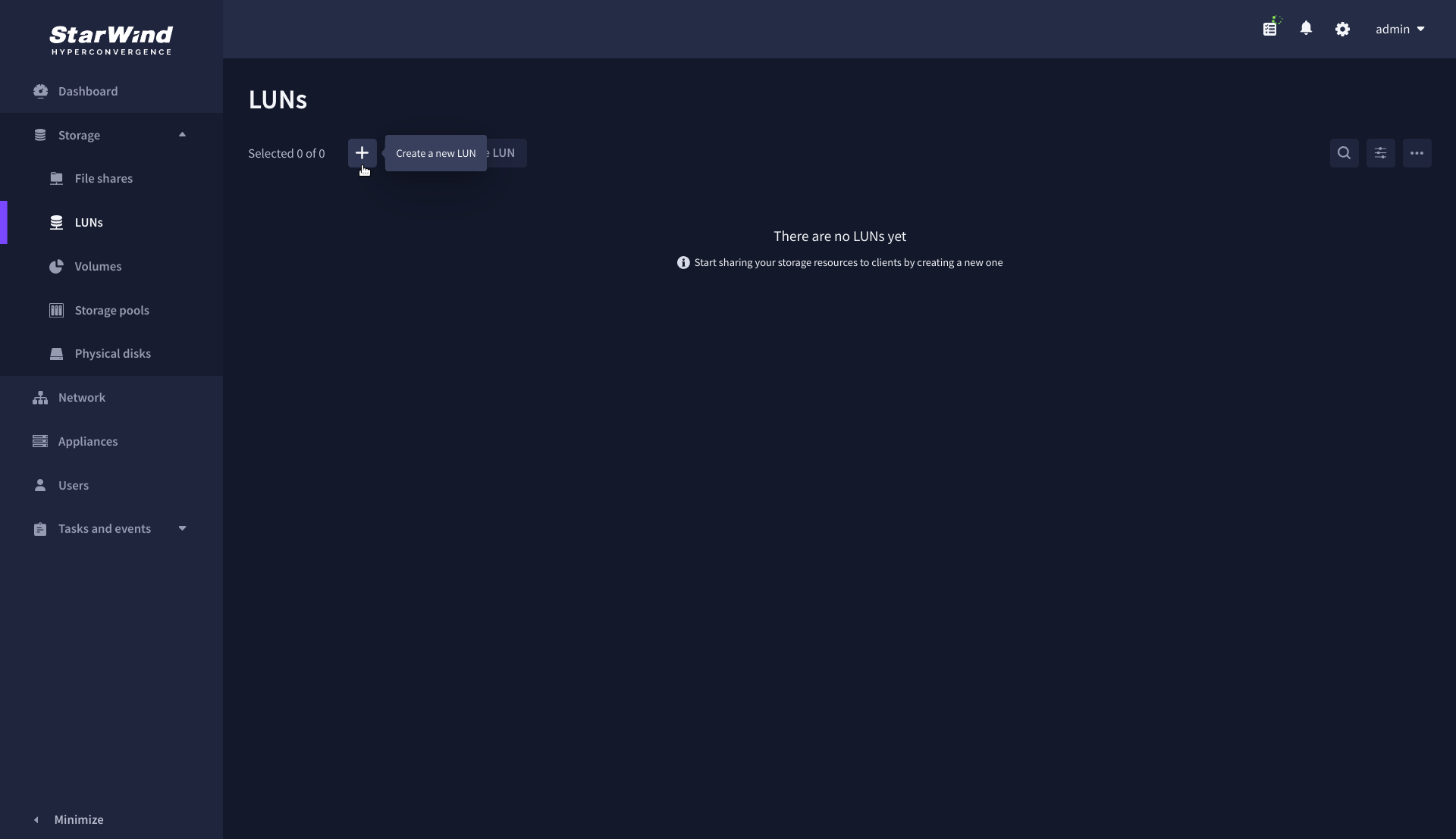
2. On the Protocols step, select the preferred storage protocol and click Next.
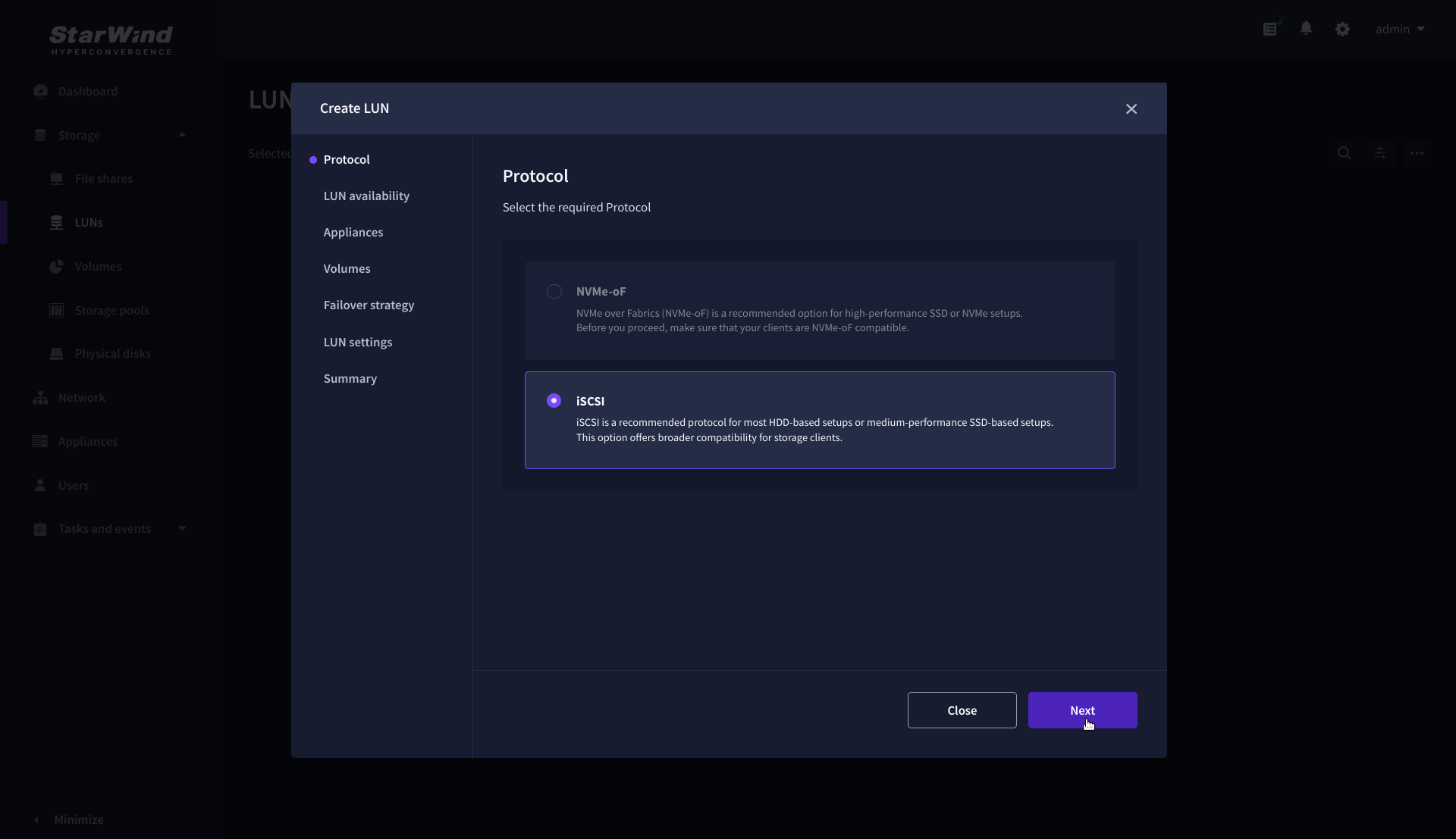
3. On the LUN availability step, select the High availability and click Next.
NOTE: The availability options for a LUN can be Standalone (without replication) or High Availability (with 2-way or 3-way replication), and are determined by the StarWind Virtual SAN license.
Below are the steps for creating a high-availability iSCSI LUN.
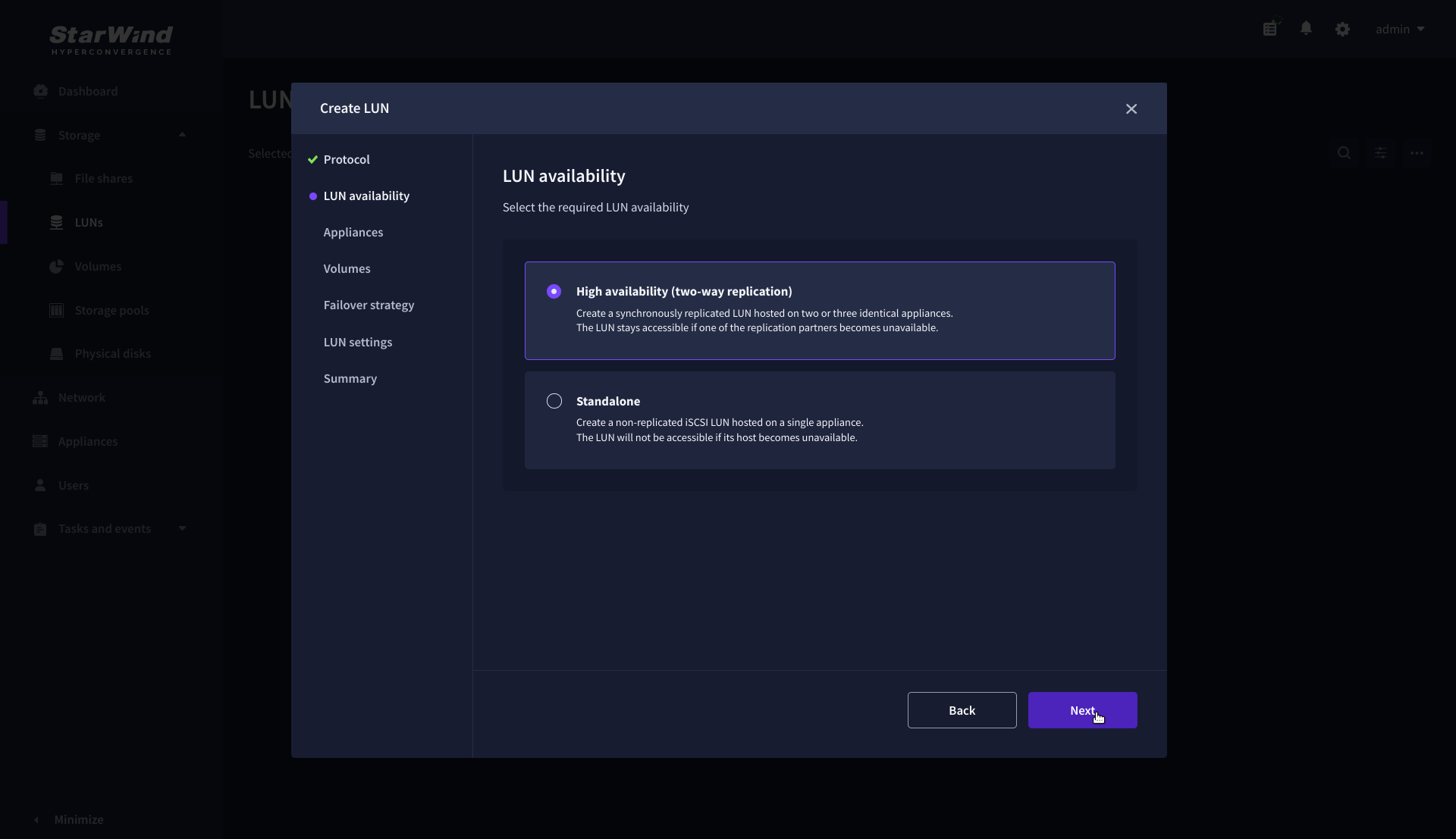
4. On the Appliances step, select partner appliances that will host new LUNs and click Next.
IMPORTANT: Selected partner appliances must have identical hardware configurations, including CPU, RAM, storage, and networking.
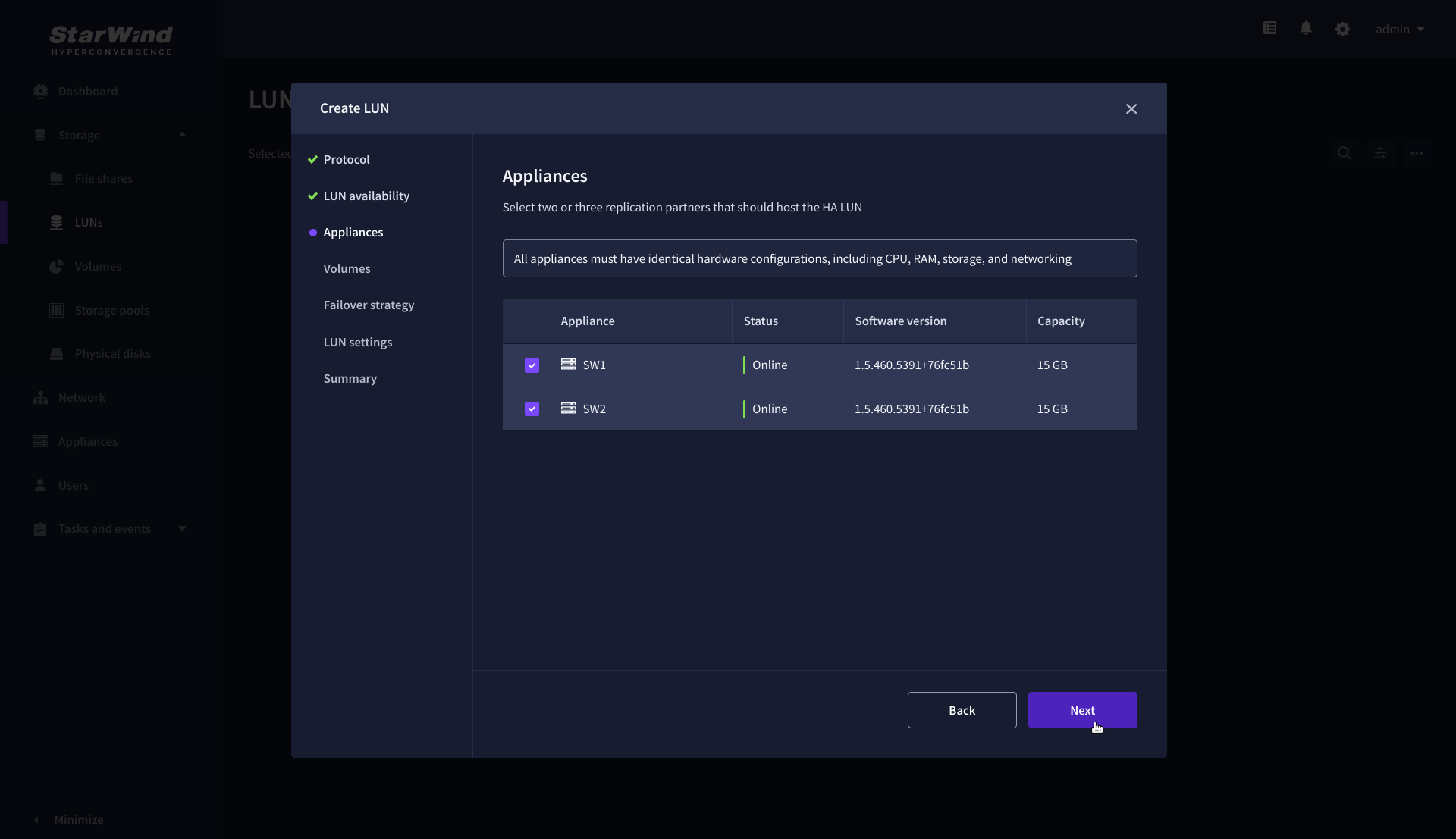
5. On the Volumes step, select the volumes for storing data on the partner appliances and click Next.
IMPORTANT: For optimal performance, the selected volumes must have identical underlying storage configurations.
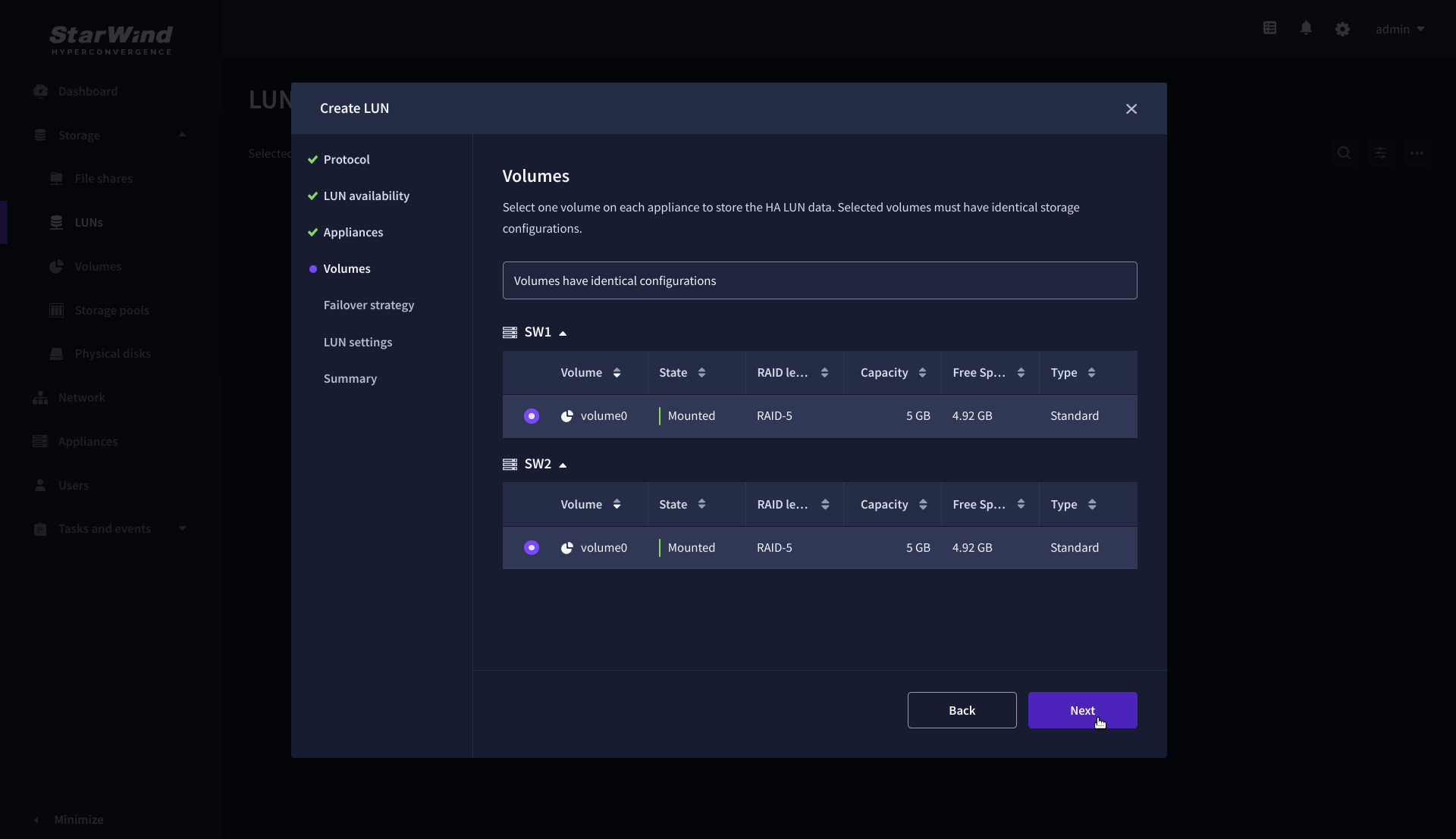
6. On the Failover strategy step, select the preferred failover strategy and click Next.
NOTE: The failover strategies for a LUN can be Heartbeat or Node Majority. In case of 2-nodes setup and None Majority failover strategy, Node witness (requires an additional third witness node), or File share witness (requires an external file share) should be configured. These options are determined by StarWind Virtual SAN license and setup configuration. Below are the steps for configuring the Heartbeat failover strategy in a two-node cluster.
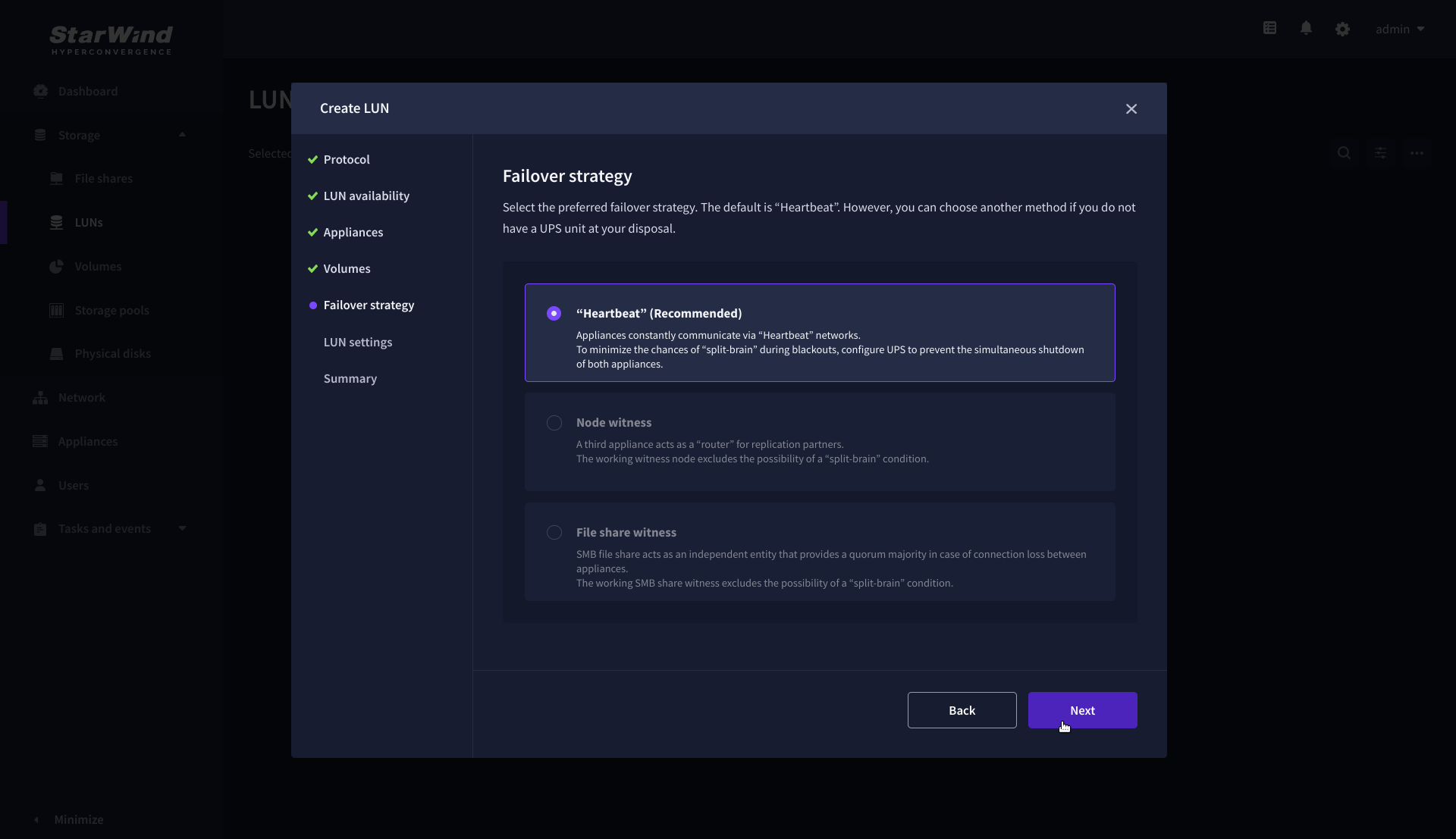
7. On the LUN settings step, specify the LUN name, size, block size, then click Next.
NOTE: For high-availability configurations, ensure that MPIO checkbox is selected.
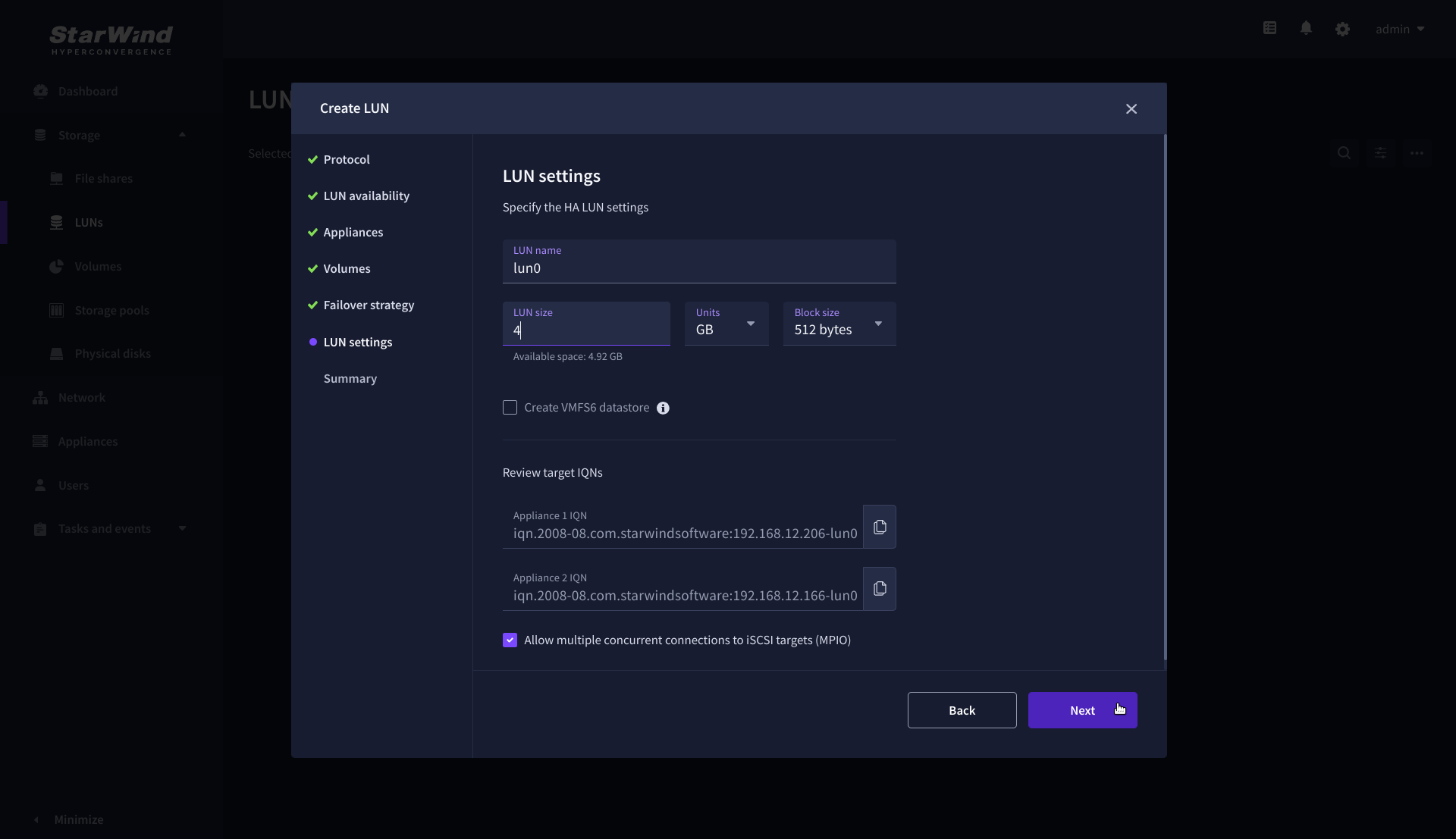
8. On the Summary step, review the LUN settings and click Create to configure new LUNs on the selected volumes.
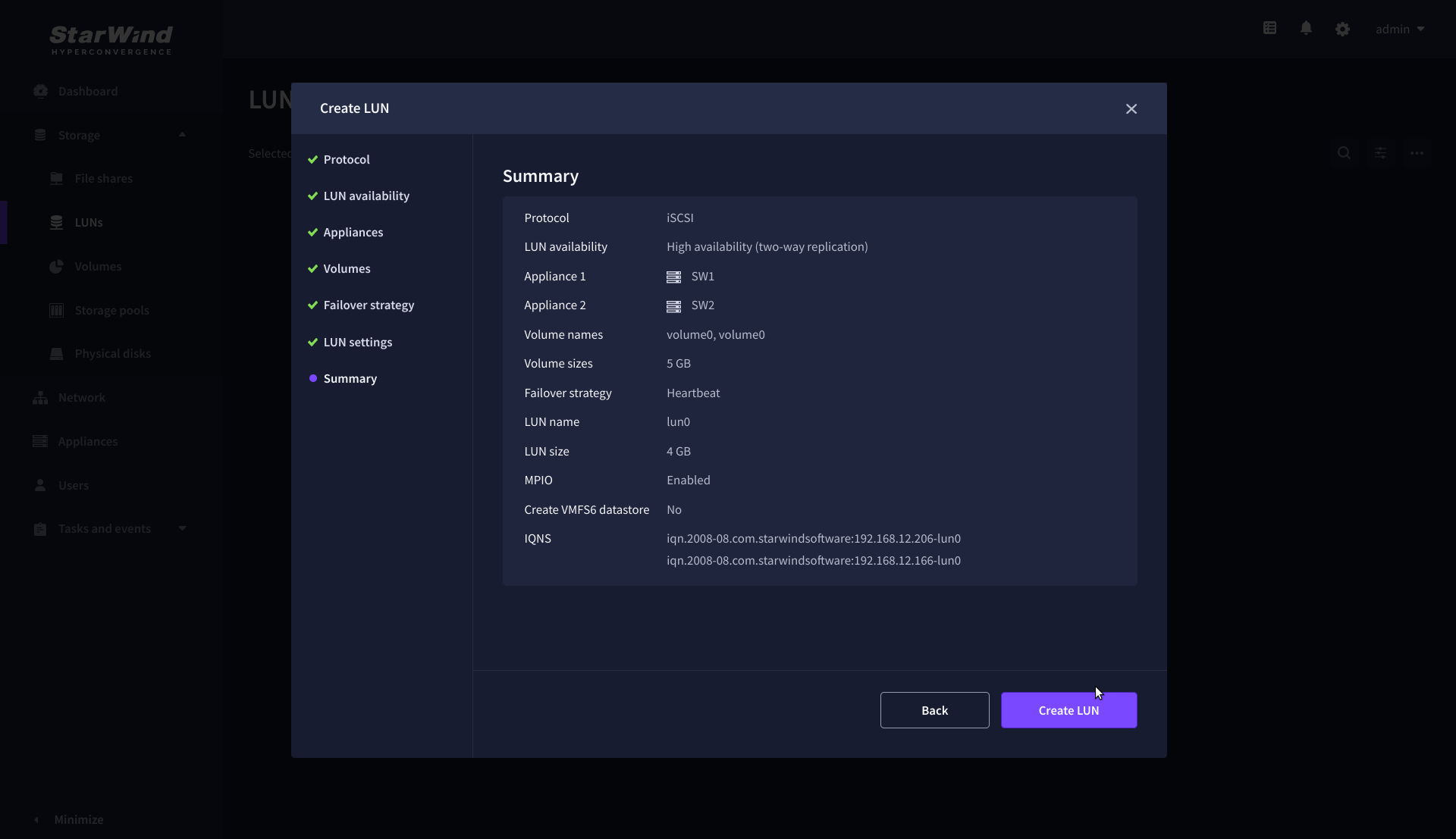
Connecting compute nodes
To establish client connections to StarWind VSAN standalone and highly available storage devices (LUNs), follow these links for configuring settings on a hypervisor of your choice:
- VMware vSphere/ESXi – Connecting StarWind LUNs to VMware vSphere servers
- Microsoft Hyper-V – Connecting StarWind virtual disk to Hyper-V servers
- oVirt – Provisioning StarWind HA Storage to Hosts
- Proxmox VE – Connecting StarWind HA Storage to Proxmox Hosts
Conclusion
By following this guide, end-users can deploy StarWind Virtual SAN on commodity servers, configure highly available storage, and prepare it for client interconnections from compute (hypervisor) nodes. The guide provides key insights and steps to ensure a seamless deployment process.

